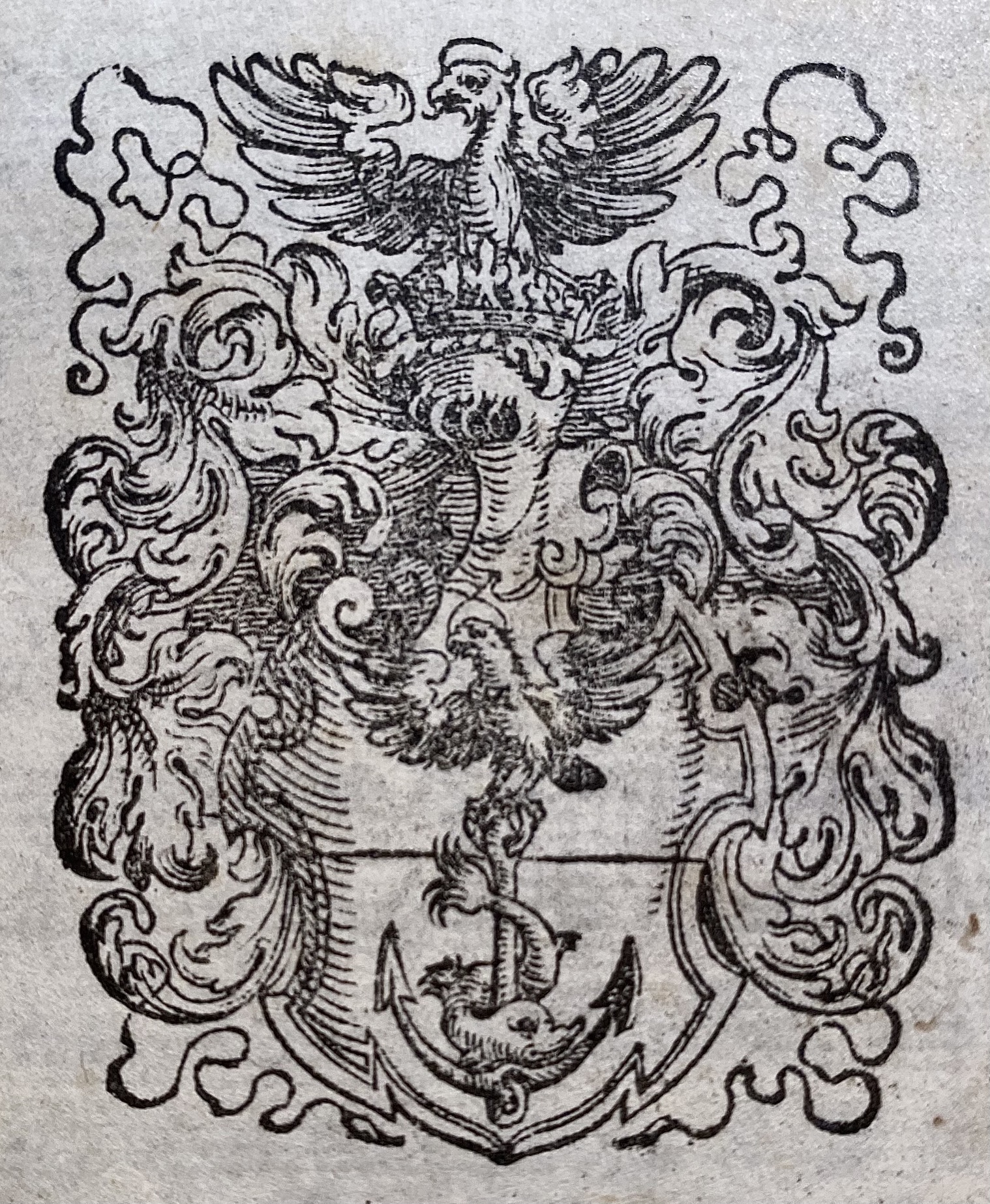-
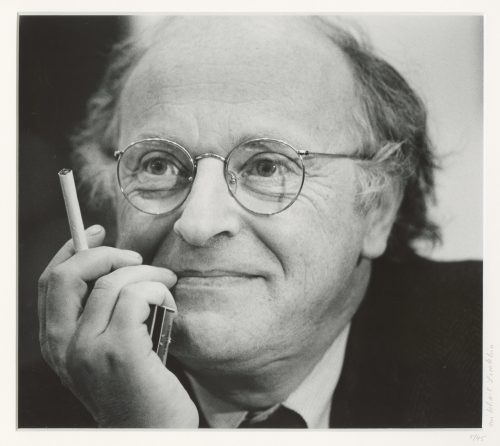 Photographic portrait of poet Joseph Brodsky, head, hand, and shoulder, three-quarters to the left, wearing glasses and with a cigarette. Pencil-signed on the mat: 5/45 • Mikhail Lemkhin; same inscription on the back of the print, and ink stamp ©Mikhail Lemkhin. Sitter: Joseph Brodsky [Иосиф Александрович Бродский ] (Russian-American-Jewish, 1940 – 1996). Size: mat: 41 x 51 cm; window: 27 x 30 cm; print: 27.7 x 35.4 cm.
Photographic portrait of poet Joseph Brodsky, head, hand, and shoulder, three-quarters to the left, wearing glasses and with a cigarette. Pencil-signed on the mat: 5/45 • Mikhail Lemkhin; same inscription on the back of the print, and ink stamp ©Mikhail Lemkhin. Sitter: Joseph Brodsky [Иосиф Александрович Бродский ] (Russian-American-Jewish, 1940 – 1996). Size: mat: 41 x 51 cm; window: 27 x 30 cm; print: 27.7 x 35.4 cm. -
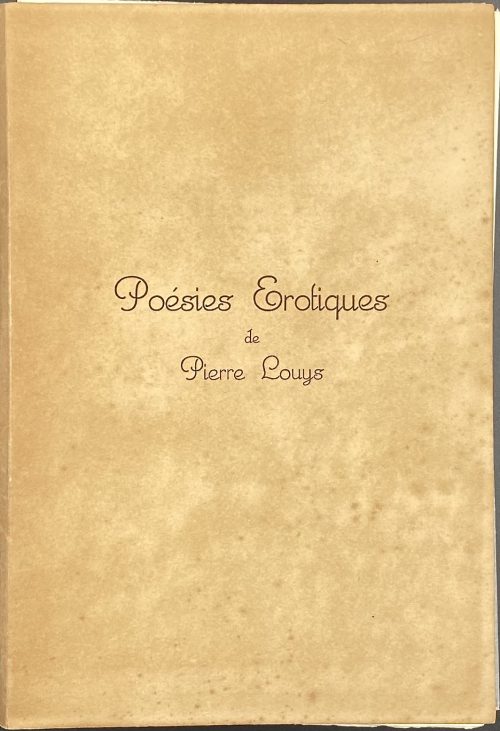 Publisher’s wrappers, 21.3 x 14.8 cm, 10 four-leave gatherings, unsigned, pp.: [8] 1-70 [2]; total 40 leaves (80 pages), illustrated with 73 in-text woodcuts in sanguine after Feodor Rojankovsky drawings. [1]4 recto reproduces the author’s handwriting. Unbound. Some foxing to the wrappers, all pages clean. Title-page: Poésies Érotiques | de | Pierre Louys | {vignette} | ROME | 1937 || Print run limited to 311 copies, 230 copies (№№ 71-300) on BFK Rives wove paper (watermarked); of which this is copy № 93. Catalogue raisonné: Dutel III 2230. Contributors: Pierre Louÿs (French, 1870 – 1925) – author. Feodor Rojankovsky [Rojan, Фёдор Степанович Рожанковский] (Russian-American, 1891 – 1970).
Publisher’s wrappers, 21.3 x 14.8 cm, 10 four-leave gatherings, unsigned, pp.: [8] 1-70 [2]; total 40 leaves (80 pages), illustrated with 73 in-text woodcuts in sanguine after Feodor Rojankovsky drawings. [1]4 recto reproduces the author’s handwriting. Unbound. Some foxing to the wrappers, all pages clean. Title-page: Poésies Érotiques | de | Pierre Louys | {vignette} | ROME | 1937 || Print run limited to 311 copies, 230 copies (№№ 71-300) on BFK Rives wove paper (watermarked); of which this is copy № 93. Catalogue raisonné: Dutel III 2230. Contributors: Pierre Louÿs (French, 1870 – 1925) – author. Feodor Rojankovsky [Rojan, Фёдор Степанович Рожанковский] (Russian-American, 1891 – 1970). -
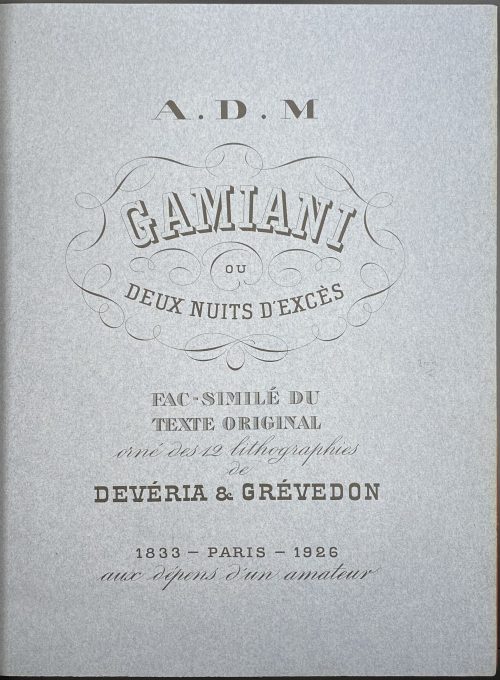 Description: ¾ contemporary red morocco over marbled boards, 33.1 x 25.8 cm, raised bands, gilt lettering to spine, in a marbled slipcase 34.2 x 25.9 cm. Printed on thick wove paper watermarked “MONTGOLFIER ANNONAY” by Canson & Montgolfier (Annonay, France). Front wrapper and title-page : A. D. M. | GAMIANI | OU | DEUX NUITS D’EXCÉS | FAC-SIMILE DU | TEXTE ORIGINAL | orné des 12 lithographies | de | DEVÉRIA & GRÉVEDON | 1833 – Paris – 1926 | aux dépens d'un amateur || Faux-t.p. (1): GAMIANI | OU | UNE NUIT D’EXCÉS | {vignette} | Bruxelles | 1833 || (fac-semilé of the original wrapper of 1833) Faux-t.p. (2): GAMIANI | OU | DEUX NUITS D’EXCÉS | {vignette} | Bruxelles | 1833 || (fac-semilé of the original wrapper of 1833) Collation: 2 blanks, 1 orig. lavender blue colour front wrapper, 1 blank, 1 h.t., 1 limitation p., 1 t.p., 3 leaves ‘Notice Bibliographique’, 32 leaves of printed text, 2 blanks, 1 brown faux t.p. (1), text in fac-semilé manuscript (7 leaves) with 8 coloured plates, 1 blank, 1 brown faux t.p. (2), 7 leaves of text with 4 plates, 2 blanks, brown back wrapper, lavender blue back wrapper, 2 blanks; total 64 leaves plus 16 plates. Pagination: [1-8] 9-75 [76] [4]; [1] 2-26; mispaginated p. 23 marked 25, f.t.p. and ffl not counted. Last four plates without letters. Limitation: a print run of 360 copies, of which 20 with ‘miniatures’ №№ 1-20, 100 with coloured plates №№ 21-120, 230 with b/w plates №№ 121-350; 10 copies not for sale, marked H. C. (hors commerce). This is copy № 201, which should be with black lithographs, but has coloured plates. According to J.-P. Dutel, the plates were printed from the original stones. For variations on Devéria & Grévedon designs for Gamiani see also: LIB-3087.2022 (Bruxelles, 1864); LIB-3093.2022 (Bruxelles, 1866); LIB-3090.2022 (Bruxelles, 1871); LIB-2902.2021 (Greman, 1911); LIB-2903.2021 (late 1940s). Catalogue raisonné: Dutel III 1640, p. 185. Contributors : Alfred de Musset (French, 1810 – 1857) – author. André Warnod [André de Sermanmagny] (French, 1885 – 1960) – author (bibliographical note) Pierre Louis Henri Grévedon (French, 1776 – 1860) – artist. Achille Devéria (French, 1800 – 1857) – artist.
Description: ¾ contemporary red morocco over marbled boards, 33.1 x 25.8 cm, raised bands, gilt lettering to spine, in a marbled slipcase 34.2 x 25.9 cm. Printed on thick wove paper watermarked “MONTGOLFIER ANNONAY” by Canson & Montgolfier (Annonay, France). Front wrapper and title-page : A. D. M. | GAMIANI | OU | DEUX NUITS D’EXCÉS | FAC-SIMILE DU | TEXTE ORIGINAL | orné des 12 lithographies | de | DEVÉRIA & GRÉVEDON | 1833 – Paris – 1926 | aux dépens d'un amateur || Faux-t.p. (1): GAMIANI | OU | UNE NUIT D’EXCÉS | {vignette} | Bruxelles | 1833 || (fac-semilé of the original wrapper of 1833) Faux-t.p. (2): GAMIANI | OU | DEUX NUITS D’EXCÉS | {vignette} | Bruxelles | 1833 || (fac-semilé of the original wrapper of 1833) Collation: 2 blanks, 1 orig. lavender blue colour front wrapper, 1 blank, 1 h.t., 1 limitation p., 1 t.p., 3 leaves ‘Notice Bibliographique’, 32 leaves of printed text, 2 blanks, 1 brown faux t.p. (1), text in fac-semilé manuscript (7 leaves) with 8 coloured plates, 1 blank, 1 brown faux t.p. (2), 7 leaves of text with 4 plates, 2 blanks, brown back wrapper, lavender blue back wrapper, 2 blanks; total 64 leaves plus 16 plates. Pagination: [1-8] 9-75 [76] [4]; [1] 2-26; mispaginated p. 23 marked 25, f.t.p. and ffl not counted. Last four plates without letters. Limitation: a print run of 360 copies, of which 20 with ‘miniatures’ №№ 1-20, 100 with coloured plates №№ 21-120, 230 with b/w plates №№ 121-350; 10 copies not for sale, marked H. C. (hors commerce). This is copy № 201, which should be with black lithographs, but has coloured plates. According to J.-P. Dutel, the plates were printed from the original stones. For variations on Devéria & Grévedon designs for Gamiani see also: LIB-3087.2022 (Bruxelles, 1864); LIB-3093.2022 (Bruxelles, 1866); LIB-3090.2022 (Bruxelles, 1871); LIB-2902.2021 (Greman, 1911); LIB-2903.2021 (late 1940s). Catalogue raisonné: Dutel III 1640, p. 185. Contributors : Alfred de Musset (French, 1810 – 1857) – author. André Warnod [André de Sermanmagny] (French, 1885 – 1960) – author (bibliographical note) Pierre Louis Henri Grévedon (French, 1776 – 1860) – artist. Achille Devéria (French, 1800 – 1857) – artist. -
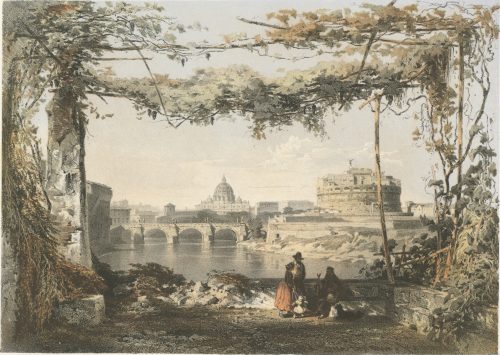
Sheet № 20 from the series of 42 сhromolithography prints 'Skizzen und Bilder aus ROM und der Umgegend' (Sketches and pictures from Rome and surroundings).
Inscriptions:
Top left: LINDEMANN-FROMMEL’S Top right: Skizzen und Bilder aus ROM und der Umgegend. Centre below: No 20 | IL CASTEL E IL PONTE SANT ANGELO, | E SAN PIETRO. Bottom left: Imp. de JACOMME et Cie. R. de Lancry, 16 Paris. Bottom centre: Stuttgart, bei FRANZ KÖHLER. Bottom right: Paris, Goupil et Cie. Editeurs.Dimensions:
Plate: 372 x 473 mm Sheet: 372 x 473 mm
Contributors:
Lindemann-Frommel, Karl (French-German, 1819 – 1891) – artist. Jacomme, Claude (French, fl. 1838 – 1857) – printer/lithographer. Goupil et Cie (Paris); Goupil, Adophe (French, 1806 – 1893) – publisher Franz Köhler (Stuttgart); Köhler, Franz (German, 1805 – 1872) – publisher. -
 Iron tsuba of almost round form with a brass outlined circular opening (sukashi) in the bottom adorned with the Myriad Treasures [takaramono, 宝物] and winter motifs inlaid in cast brass (suemon-zōgan); hitsu-ana possibly cut later, both plugged with shakudo, nakaga-ana fitted with copper sekigane. According to Merrily Baird*) (2001), the symbolism of Myriad Treasures “is associated with the Seven Gods of Good Luck, who carry them in a sack”. Among the treasures, which are said to ensure prosperity, long life, and general good fortunes, are (reading clockwise from the top):
Iron tsuba of almost round form with a brass outlined circular opening (sukashi) in the bottom adorned with the Myriad Treasures [takaramono, 宝物] and winter motifs inlaid in cast brass (suemon-zōgan); hitsu-ana possibly cut later, both plugged with shakudo, nakaga-ana fitted with copper sekigane. According to Merrily Baird*) (2001), the symbolism of Myriad Treasures “is associated with the Seven Gods of Good Luck, who carry them in a sack”. Among the treasures, which are said to ensure prosperity, long life, and general good fortunes, are (reading clockwise from the top):- Sake set [shuki, 酒器], namely flask, ladle, and cups
- Cloves [choji, 丁子]
- Purse of inexhaustible reaches [kinchaku, 巾着]
- Magic mallet [kozuchi, 小槌]
- Key to the storehouse of the Gods [kagi, 鍵]
- Rhombus, or Lozenge (hosho, 方勝), with the second ideograph meaning victory.
- Sacred (or wish-granting) gem, or jewel [hōju, 宝珠]
- Hats of invisibility [kakuregasa, 隠れ笠]
-
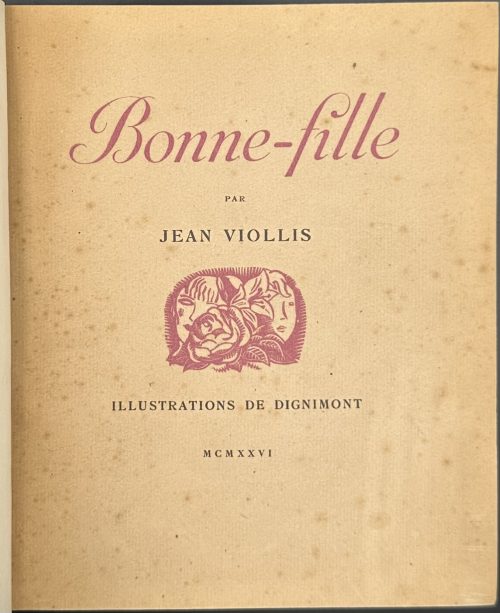 Hardcover volume, 22.5 x 19.5 cm, collated 4to, owner’s terracotta cloth with gilt-lettered black label to spine, publisher’s wrappers preserved, pp.:3 ffl, front wrapper, 3 ffl, [2] h.t./limit, [2] t.p./blank, 1-228 [2] 3 ffl, back wrapper, 3 ffl. Collation: π3 1-314 323. (130 leaves, incl. plates). Title-page (pink and black): Bonne-fille | PAR | JEAN VIOLLIS | Illustrations de | DIGNIMONT | {vignette} | A PARIS | La Collection Originale | ÉDITIONS MORNAY | 37, BOULEVARD DU MONTPARNASSE | MCMXXVI || Illustrations: 14 full-page colour plates, incl. frontispiece and endpiece, within collation but not within pagination, verso blank, and numerous head- and tailpieces and in-text stencil-coloured (au pochoir) lithography after André Dignimont. Limitation: A print run of 628 copies for sale, of which 18 on Japon Ancien, 30 on Japon Impérial, 90 on Hollande, 490 on Rives (139-628), plus 50 copies not for sale. Printed on May 12, 1926, at l’Imprimerie Kapp (Vanves), this copy is № 380. Provenance: Feodor Rojankovsky, pictorial bookplate “ИЗ КНИГ РОЖАНКОВСКАГО” to front pastedown, ms inscription to front ffl2 top “TH. ROJANKOWSKY | 14 VIII 30” in block letters. One of the possible transliterations of Feodor Rojankovsky's name is Theodor Rojankowsky. Contributors: Jean-Henri d'Ardenne deTizac [JeanViollis] (French, 1877 – 1932) – author. André Dignimont (French, 1891 – 1965) – artist. Frédéric Emile Kapp (French, 1851-193?) – printer. Georges Mornay (French, 1876 – 1935) et Antoinette Mornay – pubishers. Feodor Rojankovsky [Rojan; Фёдор Степанович Рожанковский] (Russian-American, 1891 – 1970) – provenance.
Hardcover volume, 22.5 x 19.5 cm, collated 4to, owner’s terracotta cloth with gilt-lettered black label to spine, publisher’s wrappers preserved, pp.:3 ffl, front wrapper, 3 ffl, [2] h.t./limit, [2] t.p./blank, 1-228 [2] 3 ffl, back wrapper, 3 ffl. Collation: π3 1-314 323. (130 leaves, incl. plates). Title-page (pink and black): Bonne-fille | PAR | JEAN VIOLLIS | Illustrations de | DIGNIMONT | {vignette} | A PARIS | La Collection Originale | ÉDITIONS MORNAY | 37, BOULEVARD DU MONTPARNASSE | MCMXXVI || Illustrations: 14 full-page colour plates, incl. frontispiece and endpiece, within collation but not within pagination, verso blank, and numerous head- and tailpieces and in-text stencil-coloured (au pochoir) lithography after André Dignimont. Limitation: A print run of 628 copies for sale, of which 18 on Japon Ancien, 30 on Japon Impérial, 90 on Hollande, 490 on Rives (139-628), plus 50 copies not for sale. Printed on May 12, 1926, at l’Imprimerie Kapp (Vanves), this copy is № 380. Provenance: Feodor Rojankovsky, pictorial bookplate “ИЗ КНИГ РОЖАНКОВСКАГО” to front pastedown, ms inscription to front ffl2 top “TH. ROJANKOWSKY | 14 VIII 30” in block letters. One of the possible transliterations of Feodor Rojankovsky's name is Theodor Rojankowsky. Contributors: Jean-Henri d'Ardenne deTizac [JeanViollis] (French, 1877 – 1932) – author. André Dignimont (French, 1891 – 1965) – artist. Frédéric Emile Kapp (French, 1851-193?) – printer. Georges Mornay (French, 1876 – 1935) et Antoinette Mornay – pubishers. Feodor Rojankovsky [Rojan; Фёдор Степанович Рожанковский] (Russian-American, 1891 – 1970) – provenance. -
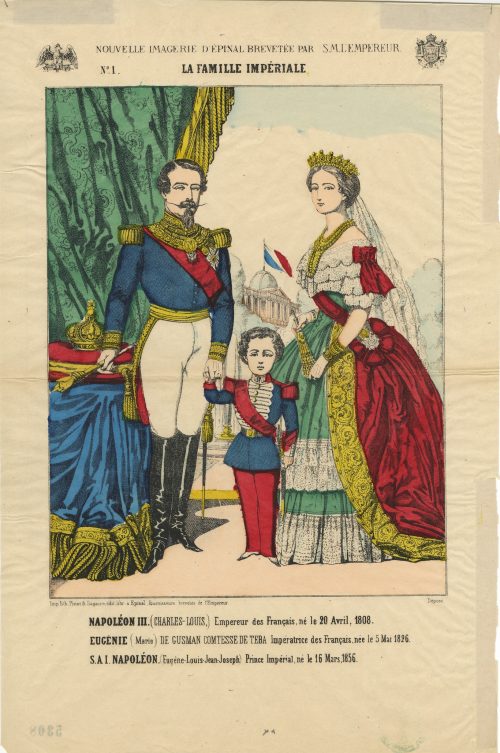 Hand-coloured woodcut on wove paper, 390 x 260 mm; black ink stamp “5308” to reverse; horizontal centerfold. Centre top: "NOUVELLE IMAGERIE D'ÉPINAL BREVETÉE PAR S.M.L’EMPEREUR" with imperial eagle and coat of arms at right and left. Below: "№ 1." — "LA FAMILLE IMPÉRIALE"; image in frame; under the image, left: "Imp lith. Pinot & Sagaire, édit. libr. à Épinal, fournisseurs brevetés de l’Empereur"; right: "Déposé". Bottom: "NAPOLÉON I. (CHARLES-LOUIS,) Empereur des Français, né le 20 Avril, 1808. | EUGÉNIE ( Marie) DE GUSMAN COMTESSE DE TEBA Impératrice des Français, née le 5 Mai 1826. | S.A I. NAPOLÉON. (Eugène-Louis-Jean-Joseph) Prince Impérial, ne le 16 Mars. 1856." Napoleon III [Charles-Louis Napoléon Bonaparte] (French, 1808 – 1873) Eugénie de Montijo [L'impératrice Eugénie] (Spanish-French, 1826 – 1920) Napoléon, Prince Imperial (Napoléon Eugène Louis Jean Joseph Bonaparte] (French, 1856 – 1879) Pinot & Sagaire (Épinal, 1861 – 1888) – enterprise, publisher/printer. Charles-François Pinot (French, 1817 – 1879) – publisher/printer.
Hand-coloured woodcut on wove paper, 390 x 260 mm; black ink stamp “5308” to reverse; horizontal centerfold. Centre top: "NOUVELLE IMAGERIE D'ÉPINAL BREVETÉE PAR S.M.L’EMPEREUR" with imperial eagle and coat of arms at right and left. Below: "№ 1." — "LA FAMILLE IMPÉRIALE"; image in frame; under the image, left: "Imp lith. Pinot & Sagaire, édit. libr. à Épinal, fournisseurs brevetés de l’Empereur"; right: "Déposé". Bottom: "NAPOLÉON I. (CHARLES-LOUIS,) Empereur des Français, né le 20 Avril, 1808. | EUGÉNIE ( Marie) DE GUSMAN COMTESSE DE TEBA Impératrice des Français, née le 5 Mai 1826. | S.A I. NAPOLÉON. (Eugène-Louis-Jean-Joseph) Prince Impérial, ne le 16 Mars. 1856." Napoleon III [Charles-Louis Napoléon Bonaparte] (French, 1808 – 1873) Eugénie de Montijo [L'impératrice Eugénie] (Spanish-French, 1826 – 1920) Napoléon, Prince Imperial (Napoléon Eugène Louis Jean Joseph Bonaparte] (French, 1856 – 1879) Pinot & Sagaire (Épinal, 1861 – 1888) – enterprise, publisher/printer. Charles-François Pinot (French, 1817 – 1879) – publisher/printer. -
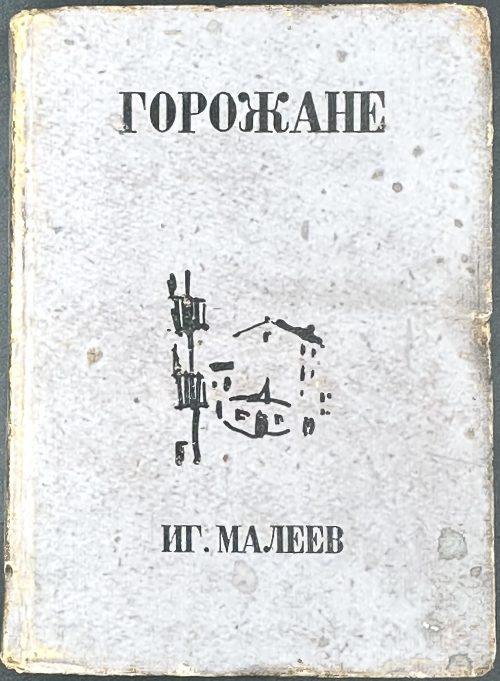 Hardcover volume, 17 x 12.5 cm, bound in lilac cardboard, lettering to covers and spine, vignette by Boris Rybchenkov to front board; pp.: [1-4] 5-188 [4]. Pencil ms to h.t. "Самалюк | Рай Кунцевское | Зав. роно" (Самалюк, зав. кунцевским районным отделом народного образования)ю Title-page: И. Г. МАЛЕЕВ | ГОРОЖАНЕ | МОСКОВСКОЕ | ТОВАРИЩЕСТВО | ПИСАТЕЛЕЙ || Print run: 5,200 copies. Contributors: Малеев, Игорь Александрович (Russian, 1904 – 1936?) – author. [Igor Maleyev] Рыбченков, Борис Федорович (Russian, 1899 – 1994) – artist. [Boris Rybchenkov]
Hardcover volume, 17 x 12.5 cm, bound in lilac cardboard, lettering to covers and spine, vignette by Boris Rybchenkov to front board; pp.: [1-4] 5-188 [4]. Pencil ms to h.t. "Самалюк | Рай Кунцевское | Зав. роно" (Самалюк, зав. кунцевским районным отделом народного образования)ю Title-page: И. Г. МАЛЕЕВ | ГОРОЖАНЕ | МОСКОВСКОЕ | ТОВАРИЩЕСТВО | ПИСАТЕЛЕЙ || Print run: 5,200 copies. Contributors: Малеев, Игорь Александрович (Russian, 1904 – 1936?) – author. [Igor Maleyev] Рыбченков, Борис Федорович (Russian, 1899 – 1994) – artist. [Boris Rybchenkov] -
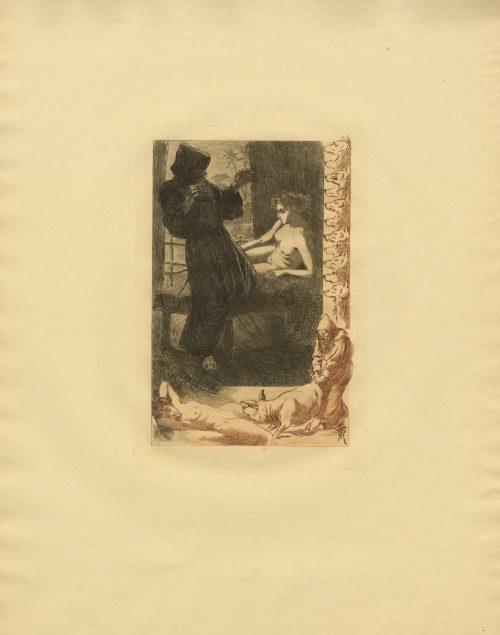 Set of 21 etchings by Martin van Maele for the English edition of ‘Thais’ by Anatole France published in London by Charles Carrington in 1901. Printed on vowe paper without a watermark in two colours with the black image and sepia historiated border. All etchings are inscribed with the artist's monogram; one of the etchings bears inscriptions ORGUEIL, LUXURE, DOUTE (mirror image). Dimensions: sheet: 317 x 250 mm; plate: 170 x 115 mm; image: 155 x 100 mm. Catalogue raisonné: S. A. Perry: № 64. Per Perry, the edition was printed in 500 copies on 'handmade paper watermarked 'Van Gelder'. Contributor: Martin van Maële [Martin, Maurice François Alfred] (French, 1863 – 1926)
Set of 21 etchings by Martin van Maele for the English edition of ‘Thais’ by Anatole France published in London by Charles Carrington in 1901. Printed on vowe paper without a watermark in two colours with the black image and sepia historiated border. All etchings are inscribed with the artist's monogram; one of the etchings bears inscriptions ORGUEIL, LUXURE, DOUTE (mirror image). Dimensions: sheet: 317 x 250 mm; plate: 170 x 115 mm; image: 155 x 100 mm. Catalogue raisonné: S. A. Perry: № 64. Per Perry, the edition was printed in 500 copies on 'handmade paper watermarked 'Van Gelder'. Contributor: Martin van Maële [Martin, Maurice François Alfred] (French, 1863 – 1926) -
 Iron tsuba of oval form with design of a gourd or aubergine vine with fruits, leaves, and blossoms climbing a trellis, and a fence in yellow brass and red copper flat inlay (hira-zōgan); inlay engraved. Two latticed windows represented by openwork (sukashi). The iron web has deep black patina. The seller attributes this tsuba to Heianjo-Namban school, whatever it means. Momoyama or early Edo period, 17th century. Kaga or Heianjō School. Unsigned. Height: 77.3, Width: 73.1, Thickness at seppa-dai: 3.6 mm.
Iron tsuba of oval form with design of a gourd or aubergine vine with fruits, leaves, and blossoms climbing a trellis, and a fence in yellow brass and red copper flat inlay (hira-zōgan); inlay engraved. Two latticed windows represented by openwork (sukashi). The iron web has deep black patina. The seller attributes this tsuba to Heianjo-Namban school, whatever it means. Momoyama or early Edo period, 17th century. Kaga or Heianjō School. Unsigned. Height: 77.3, Width: 73.1, Thickness at seppa-dai: 3.6 mm. -
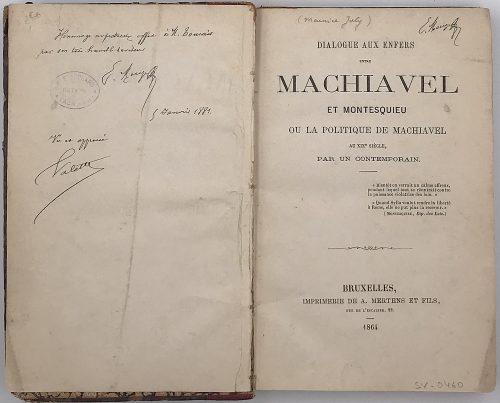 Title page: DIALOGUE AUX ENFERS | ENTRE | MACHIAVEL | ET MONTESQUIEU | OU LA POLITIQUE DE MACHIAVEL | AU XIXe SIÈCLE, | PAR UN CONTEMPORAIN. | {6 lines of citations} | ~ | BRUXELLES, | IMPRIMERIE DE A. MERTENS ET FILS, | RUE DE L’ESCALIER, 22. | 1864 ||
Title page: DIALOGUE AUX ENFERS | ENTRE | MACHIAVEL | ET MONTESQUIEU | OU LA POLITIQUE DE MACHIAVEL | AU XIXe SIÈCLE, | PAR UN CONTEMPORAIN. | {6 lines of citations} | ~ | BRUXELLES, | IMPRIMERIE DE A. MERTENS ET FILS, | RUE DE L’ESCALIER, 22. | 1864 ||Description: 17.9 x 12 cm, quarter red morocco over marbled boards, spine with raised bands, gilt bees in compartments, gilt lettering, marbled endpapers, ffep cut out top 1/4, ffep and h.t. loose.
Collation: 12mo; fep, π4 1-2712, 292, fep.; total 174 leaves. Pagination: [2 h.t] [2 t.p.] [i] ii-iii [iv] [1] 2-337 [338] [2 errata].Inscriptions and markings: "Hommage respectueux offert à M. Bourdais par son très humble serviteur, 5 Janvier 1881". Signature: E. Rouger (?) "Vu et approuvé". "Valatte". Ink stamp: "M<aîtr>e E. Brouard - Notaire a Laon Aisne".
Other copies: LIB-1034.2016 and LIB-2913.2021. Other related objects: SVVP-0062.2021. The publication was funded by the author and smuggled into France. Contributors: Maurice Joly (French, 1829 – 1878) -
 Katsukawa Shunshō ( 勝川 春章; 1726 – 19 January 1793).
Katsukawa Shunshō ( 勝川 春章; 1726 – 19 January 1793).SIZE: 12.5 x 5.75 in.
-
 Iron tsuba of mokko form (quatrefoil) decorated with a pair of cherry blossoms (sakura) in small openwork (ko-sukashi) and inlaid in brass (suemon-zōgan) with designs of waves, distant pines, chrysanthemum flowers in halves, tendrils and leaves, lightning or thunder symbol (inazuma), flying geese and family chrests (mon): two interlocked rings (wachigai) on the face, and three encircled stripes (maru-no-uchi-ni-mitsuhikiryo) - kamon of the Kikkawa clan - on the reverse. Hitsu-ana outlined with inlay of brass wire. Surface treated with lacquer. Copper sekigane. Though some consider this type of tsuba to resemble Heianjo school, “...the brass trim around the hitsu-ana is a characteristics of Ōnin work” [Japanese sword guards. Onin – Heianjo – Yoshiro. Gary D. Murtha. GDM Publications, 2016; p. 27.]. The Ōnin origin is reinforced by scattered ten-zōgan elements here and there through the plate. It is possible that the tsuba was initially of round form and later trimmed to mokko shape. Mid Muromachi period; 15th century. Dimensions: Height: 87.2 mm; Width: 87.9 mm; Thickness at seppa-dai: 3.6 mm.
Iron tsuba of mokko form (quatrefoil) decorated with a pair of cherry blossoms (sakura) in small openwork (ko-sukashi) and inlaid in brass (suemon-zōgan) with designs of waves, distant pines, chrysanthemum flowers in halves, tendrils and leaves, lightning or thunder symbol (inazuma), flying geese and family chrests (mon): two interlocked rings (wachigai) on the face, and three encircled stripes (maru-no-uchi-ni-mitsuhikiryo) - kamon of the Kikkawa clan - on the reverse. Hitsu-ana outlined with inlay of brass wire. Surface treated with lacquer. Copper sekigane. Though some consider this type of tsuba to resemble Heianjo school, “...the brass trim around the hitsu-ana is a characteristics of Ōnin work” [Japanese sword guards. Onin – Heianjo – Yoshiro. Gary D. Murtha. GDM Publications, 2016; p. 27.]. The Ōnin origin is reinforced by scattered ten-zōgan elements here and there through the plate. It is possible that the tsuba was initially of round form and later trimmed to mokko shape. Mid Muromachi period; 15th century. Dimensions: Height: 87.2 mm; Width: 87.9 mm; Thickness at seppa-dai: 3.6 mm. -
 Shingen school tsuba with woven wire pattern. Iron core, woven brass wire. Height: 72.5 mm; Width 69.8 mm; Thickness at seppa-dai: 4.0 mm. Weight 88.8 g. Late Muromachi, 16th century. SOLD http://varshavskycollection.com/shingen-tsuba/
Shingen school tsuba with woven wire pattern. Iron core, woven brass wire. Height: 72.5 mm; Width 69.8 mm; Thickness at seppa-dai: 4.0 mm. Weight 88.8 g. Late Muromachi, 16th century. SOLD http://varshavskycollection.com/shingen-tsuba/ -
 Similar image at MFA under title: Actors and Women in the Snow MFA ACCESSION NUMBER: 11.13568 Date: 1809 (Bunka 6), 12th month Artist: Utagawa Toyokuni I (1769–1825) Publisher Tsuruya Kinsuke (firm name Sôkakudô), № 554 in Marks's "Publishers". DIMENSIONS: Vertical ôban; 38.2 x 25.8 cm (15 1/16 x 10 3/16 in.) MEDIUM OR TECHNIQUE: Woodblock print (nishiki-e); ink and color on paper. Signed: Toyokuni ga (豊国画) Censor's seals: kiwame (改印:極) MFA assumes that this may be "one sheet of incomplete triptych?"
Similar image at MFA under title: Actors and Women in the Snow MFA ACCESSION NUMBER: 11.13568 Date: 1809 (Bunka 6), 12th month Artist: Utagawa Toyokuni I (1769–1825) Publisher Tsuruya Kinsuke (firm name Sôkakudô), № 554 in Marks's "Publishers". DIMENSIONS: Vertical ôban; 38.2 x 25.8 cm (15 1/16 x 10 3/16 in.) MEDIUM OR TECHNIQUE: Woodblock print (nishiki-e); ink and color on paper. Signed: Toyokuni ga (豊国画) Censor's seals: kiwame (改印:極) MFA assumes that this may be "one sheet of incomplete triptych?" -

Kyo school iron tsuba of round form decorated with an eight-plank bridge (yatsuhashi) and irises (kakitsubata) in openwork (sukashi).
Late Muromachi period, Tenbun era (early 16th centiry).Dimensions: 80.0 x 77.2 x 4.1 mm.
The design alludes to the scene in 'Ise Monogatari', where Ariwara no Narihira being exiled from Kyoto to the Kanto region crossed the eight-plank bridge at Mikawa looking at the irises in bloom and composed a poem expressing his desire to return to Kyoto. A lot of tsuba have been produced with the similar design.
Reference: Masterpieces from the Sasano collection, 1994, p. 98, №69. -
 Iron tsuba of round form with a dense combination of symbols: slanting rays of light (shakoh) Christian motif (Jesuit's IHS symbol), also often described as "tokei" or "clock gear", wild goose in flight, bracken, and lozenges in openwork (sukashi). Copper sekigane. Edo period.
Iron tsuba of round form with a dense combination of symbols: slanting rays of light (shakoh) Christian motif (Jesuit's IHS symbol), also often described as "tokei" or "clock gear", wild goose in flight, bracken, and lozenges in openwork (sukashi). Copper sekigane. Edo period.Size: 76.0 x 72.6 x 6.2 mm
Unsigned.
For information regarding shakoh tsuba see article 'Kirishitan Ikenie Tsuba by Fred Geyer at Kokusai Tosogu Kai; The 2nd International Convention & Exhibition, October 18-23, 2006, pp. 84-91.
-
 Torii Kiyonaga (鳥居 清長; 1752 – June 28, 1815) Signed: Kiyonaga ga (清長画)
Torii Kiyonaga (鳥居 清長; 1752 – June 28, 1815) Signed: Kiyonaga ga (清長画)References: No references whatsoever, not in Pins.
-
 Le Petit Chaperon rouge (Little Red Riding Hood), three wood engravings by Gustave Doré, 1864: "En passant dans un bois elle rencontra compère le Loup"; "Le Chaperon rouge fut bien étonné de voir comment sa grand'mère était faite en son déshabillé"; "Cela n'empêche pas qu'avec ses gran dents il avait mangé une bonne grand'mère". Engraved by Adolphe Pannemaker. Le Petit Poucet (Little Thumb), one wood engraving by Gustave Doré, 1864: "Une bonne femme vint leur ouvrir". Engraved by Héliodore-Joseph Pisan. La Belle au bois dormant (Sleeping Beauty), one wood engraving by Gustave Doré, 1864: "Il marcha vers le château qu'il voyait au bout d'une grande avenue où il entra". Engraved by Héliodore-Joseph Pisan. Medium: Paper; Wood engraving. Illustrations for P.-J. Hetzel's edition of Perrault's Fairy Tales (Les Contes de Perrault) by Gustave Doré published in 1864. Size: frame: 428 x 302 mm; sheet: 280 x 231 mm; image: 194 x 244 mm.
Le Petit Chaperon rouge (Little Red Riding Hood), three wood engravings by Gustave Doré, 1864: "En passant dans un bois elle rencontra compère le Loup"; "Le Chaperon rouge fut bien étonné de voir comment sa grand'mère était faite en son déshabillé"; "Cela n'empêche pas qu'avec ses gran dents il avait mangé une bonne grand'mère". Engraved by Adolphe Pannemaker. Le Petit Poucet (Little Thumb), one wood engraving by Gustave Doré, 1864: "Une bonne femme vint leur ouvrir". Engraved by Héliodore-Joseph Pisan. La Belle au bois dormant (Sleeping Beauty), one wood engraving by Gustave Doré, 1864: "Il marcha vers le château qu'il voyait au bout d'une grande avenue où il entra". Engraved by Héliodore-Joseph Pisan. Medium: Paper; Wood engraving. Illustrations for P.-J. Hetzel's edition of Perrault's Fairy Tales (Les Contes de Perrault) by Gustave Doré published in 1864. Size: frame: 428 x 302 mm; sheet: 280 x 231 mm; image: 194 x 244 mm. -

Iron tsuba with chrysanthemum design in openwork (sukashi). Copper sekigane.
Late Heian through Kamakura period (ca. 1150 - 1200's).
Size: 78.4 x 60.9 x 3.5 mm; weight: 45.7 g
Provenance: Boris Markhasin Message from Boris Markhasin (13-AUG-2019): It is a very rudimentary tachi tsuba, and the iron is old and really nothing to draw attention. However, this is a very old tsuba, and that is what makes it very special and an important study piece. This tsuba likely dates to the late Heian through Kamakura (ca. 1150 - 1200's) -- by consensus, since such examples are extremely rare, and none are mounted to my knowledge, so few direct analogues. The form is interesting for a variety of reasons. The smaller size, an oval form is associated more with 12th/13th c styles. The sukashi kiku motif is very interesting as it clearly pushes back the dating of large scale sukashi far back in time. This shouldn't be surprising, but for some reason, we (really mainly westerners) naively tend to associate sukashi with the Muromachi and younger. The two missing spokes are by consensus likely later removals to accommodate kozuka and kogai -- but this is not certain, and it could be an original styling. A key kantei point is the elongate, narrow, slightly squared seppa dai. This is a characteristic of early koshirae, which were much thinner and more delicate than the types we are used to seeing that date pretty much to the late Muromachi and later. I am always amazed when I have a chance to interrogate early koshirae at how thin they are - I want to call them fragile, but they were actually quite resilient. The walls were super thin, but the top and bottom edges were a bit thicker, providing a bit of structural support... but this is another thread topic. Of all the tsuba I have owned, this is the tsuba that has most clearly reflected the shape of the old style of saya / tsuka. -
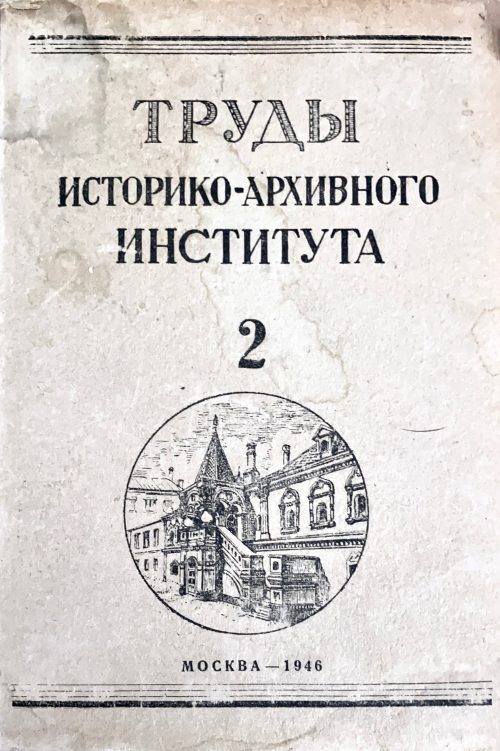 Елизавета Николаевна Данилова. "Завещание" Петра Великого / Под ред. Александр Игнатьевич Андреева. // В сборнике: Труды Историко-архивного института, том 2, 1946. (Кафедра вспомогательных исторических дисциплин). – с. 202-270. Москва: Главное архивное управление МВД Союза ССР. Историко-архивный институт, 1946. Тираж: 3000 экз.
Елизавета Николаевна Данилова. "Завещание" Петра Великого / Под ред. Александр Игнатьевич Андреева. // В сборнике: Труды Историко-архивного института, том 2, 1946. (Кафедра вспомогательных исторических дисциплин). – с. 202-270. Москва: Главное архивное управление МВД Союза ССР. Историко-архивный институт, 1946. Тираж: 3000 экз. -
 Artist: Utagawa Kuniyoshi [歌川 國芳] (Japanese, 1798 – 1861).
Artist: Utagawa Kuniyoshi [歌川 國芳] (Japanese, 1798 – 1861).Title: Suzume fukube [美人団扇絵] (Sparrow and gourds).
Series: Kacho awase [花鳥合] (Collection of flowers and birds).
Publisher: Aritaya Seiemon [有田屋 清右衛門] (Japanese, fl. c. 1830 – 1862); Seal: Marks 17-011 | 014d.Signed: Ichiyosai Kuniyoshi ga in a red cartouche and sealed with paulownia crest (kiri mon).
Size: Uchiwa-e (untrimmed fan print) 296 x 230 mm.
Double nanushi censor seals: Kinugasa & Watanabe, Kaei 2-3 (1849–50).
Ref.: Kuniyoshi Project. -
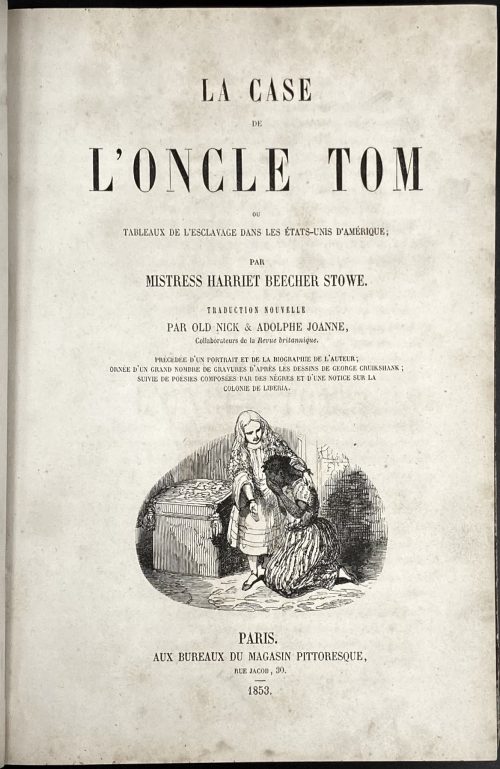 1st French edition (Paris, 1853) of Harriet Beecher Stowe's book Uncle Tom's Cabin; or, Life Among the Lowly, with 27 illustrations on wood by George Cruikshank (British, 1792 – 1878), translated into French by Paul-Émile Daurand-Forgues [pseudonym Old Nick] (French, 1813 – 1883) and Adolphe Joanne (French, 1813 – 1881). Title: LA CASE | DE | L'ONCLE TOM | OU | TABLE AUX DE L'ESCLAVAGE DANS LES ÉTATS-UNIS D'AMÉRIQUE ; | PAR MISTRESS HARRIET BEECHER STOWE. | TRADUCTION NOUVELLE | PAR OLD NICK & ADOLPHE JOANNE, | Collaboarteurs de la Revue britannique, | PRÉCÉDÉE D'UN PORTRAIT ET DE LA BIOGRAPHIE DE L'AUTEUR; | ORNÉE D'IU GRAND NOMBRE DE GRAVURES D'APRES LES DESSINS DE GEORGE CRUIKSHANK ; | SUIVIE DE POÉSIES COMPOSÉES PAR DES NÈGRES ET D'UNE NOTICE SUR LA | COLONIE DE LIBERIA. | [vignette] | PARIS. | AUX BUREAUX DU MAGASIN PITTORESQUE, | RUE JACOB, 30. | 1853. Pagination: ffl blank; [i-ii]: h.t. with stamped letters D. W. in the upper centre / imprim. to verso; [iii-iv] t.p. / blank; [v-vi] blank / frontispiece: portrait of Harriet Beecher Stowe, half-length to left, with hair in ringlets, and a shawl over shoulders, landscape behind, Henry Linton (British, 1815 – 1899) after Henry Anelay (British,1817 – 1883), wood-engraving with letterpress; [vij] Viij-xij; [1] 2-563 [564]; bfl blank; illustrations: 27 woodcuts by George Cruikshank. Collation: 8vo, π7 (1)–(35)8 363 Binding: Quarter brown calf, spine with raised bands, gilt-ruled compartments, title lettering, "D. W." in the bottom, marbled boards and endpapers. Dimensions: 24.1 x 16.4 cm. Catalogue raisonné: Albert M. Cohen (1924), №777, p. 221. "An edition was published in French with the woodcuts direct from the blocks, not, as in the English, merely from the stereotypes. The illustrations are far more impressive than those of Cassell's edition".
1st French edition (Paris, 1853) of Harriet Beecher Stowe's book Uncle Tom's Cabin; or, Life Among the Lowly, with 27 illustrations on wood by George Cruikshank (British, 1792 – 1878), translated into French by Paul-Émile Daurand-Forgues [pseudonym Old Nick] (French, 1813 – 1883) and Adolphe Joanne (French, 1813 – 1881). Title: LA CASE | DE | L'ONCLE TOM | OU | TABLE AUX DE L'ESCLAVAGE DANS LES ÉTATS-UNIS D'AMÉRIQUE ; | PAR MISTRESS HARRIET BEECHER STOWE. | TRADUCTION NOUVELLE | PAR OLD NICK & ADOLPHE JOANNE, | Collaboarteurs de la Revue britannique, | PRÉCÉDÉE D'UN PORTRAIT ET DE LA BIOGRAPHIE DE L'AUTEUR; | ORNÉE D'IU GRAND NOMBRE DE GRAVURES D'APRES LES DESSINS DE GEORGE CRUIKSHANK ; | SUIVIE DE POÉSIES COMPOSÉES PAR DES NÈGRES ET D'UNE NOTICE SUR LA | COLONIE DE LIBERIA. | [vignette] | PARIS. | AUX BUREAUX DU MAGASIN PITTORESQUE, | RUE JACOB, 30. | 1853. Pagination: ffl blank; [i-ii]: h.t. with stamped letters D. W. in the upper centre / imprim. to verso; [iii-iv] t.p. / blank; [v-vi] blank / frontispiece: portrait of Harriet Beecher Stowe, half-length to left, with hair in ringlets, and a shawl over shoulders, landscape behind, Henry Linton (British, 1815 – 1899) after Henry Anelay (British,1817 – 1883), wood-engraving with letterpress; [vij] Viij-xij; [1] 2-563 [564]; bfl blank; illustrations: 27 woodcuts by George Cruikshank. Collation: 8vo, π7 (1)–(35)8 363 Binding: Quarter brown calf, spine with raised bands, gilt-ruled compartments, title lettering, "D. W." in the bottom, marbled boards and endpapers. Dimensions: 24.1 x 16.4 cm. Catalogue raisonné: Albert M. Cohen (1924), №777, p. 221. "An edition was published in French with the woodcuts direct from the blocks, not, as in the English, merely from the stereotypes. The illustrations are far more impressive than those of Cassell's edition". -
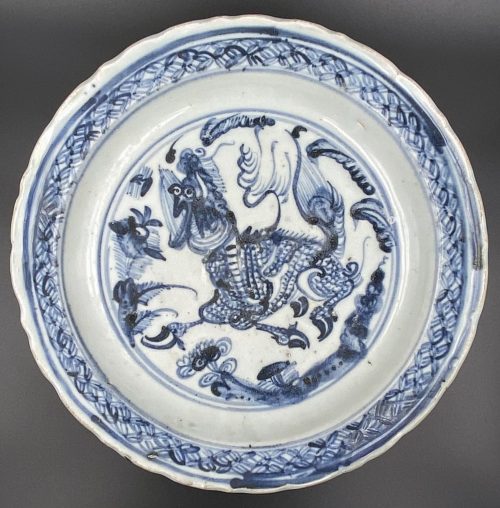 Footed plate with scalloped rim, centre decorated with running yak or another even-toed animal among flowers, jewel diaper pattern to the inner lip; foliage motif to the outside is bordered with foliage above and lotus leaves below. Porcelain with underglaze blue decoration. Ming Dynasty [大明] (1368 – 1644); Wanli Era (1572 – 1620); Late 16th – Early 17th century. Diameter: 25.5 cm; Height: 4.2 cm
Footed plate with scalloped rim, centre decorated with running yak or another even-toed animal among flowers, jewel diaper pattern to the inner lip; foliage motif to the outside is bordered with foliage above and lotus leaves below. Porcelain with underglaze blue decoration. Ming Dynasty [大明] (1368 – 1644); Wanli Era (1572 – 1620); Late 16th – Early 17th century. Diameter: 25.5 cm; Height: 4.2 cm -
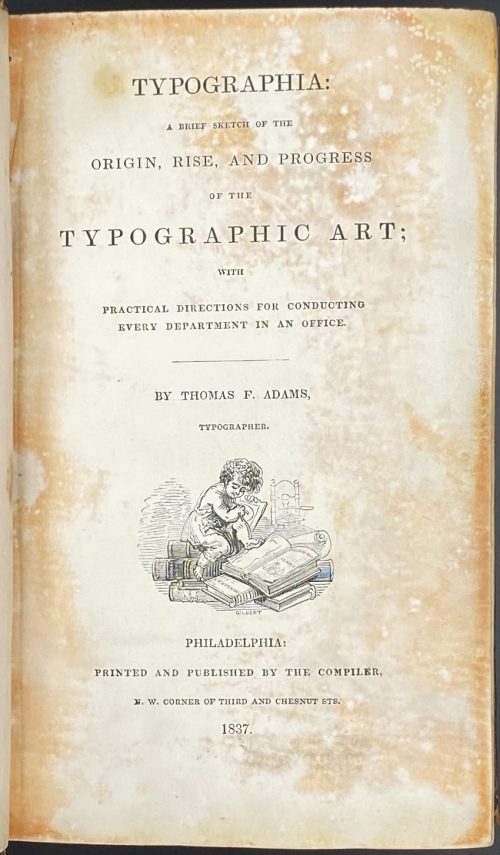 Title: TYPOGRAPHIA : | A BRIEF SKETCH OF THE | ORIGIN, RISE, AND PROGRESS | OF THE | TYPOGRAPHIC ART; | WITH | PRACTICAL DIRECTIONS FOR CONDUCTING | EVERY DEPARTMENT IN AN OFFICE. | BY THOMAS F. ADAMS, TYPOGRAPHER. | {vignette} | PHILADELPHIA: | PRINTED AND PUBLISHED BY THE COMPILER, | N. W. CORNER OF THIRD AND CHESNUT STS. | 1837. || Pagination: Engraved frontispiece w/guard, t.p. / blank, [1-3] 4-372 [8], incl. Index and Directions to binder. Collation: 12mo; 1-31(6). Binding: contemporary full brown speckled calf, flat spine bands with gilt double-fillets, dark brown lettering label. Note: Plagiarism of John Johnson's (British, 1777 – 1848) book Typographia, or, The printers' instructor published in London by Longman, Hurst, Rees, Orme, Brown & Green in 1824. .
Title: TYPOGRAPHIA : | A BRIEF SKETCH OF THE | ORIGIN, RISE, AND PROGRESS | OF THE | TYPOGRAPHIC ART; | WITH | PRACTICAL DIRECTIONS FOR CONDUCTING | EVERY DEPARTMENT IN AN OFFICE. | BY THOMAS F. ADAMS, TYPOGRAPHER. | {vignette} | PHILADELPHIA: | PRINTED AND PUBLISHED BY THE COMPILER, | N. W. CORNER OF THIRD AND CHESNUT STS. | 1837. || Pagination: Engraved frontispiece w/guard, t.p. / blank, [1-3] 4-372 [8], incl. Index and Directions to binder. Collation: 12mo; 1-31(6). Binding: contemporary full brown speckled calf, flat spine bands with gilt double-fillets, dark brown lettering label. Note: Plagiarism of John Johnson's (British, 1777 – 1848) book Typographia, or, The printers' instructor published in London by Longman, Hurst, Rees, Orme, Brown & Green in 1824. . -
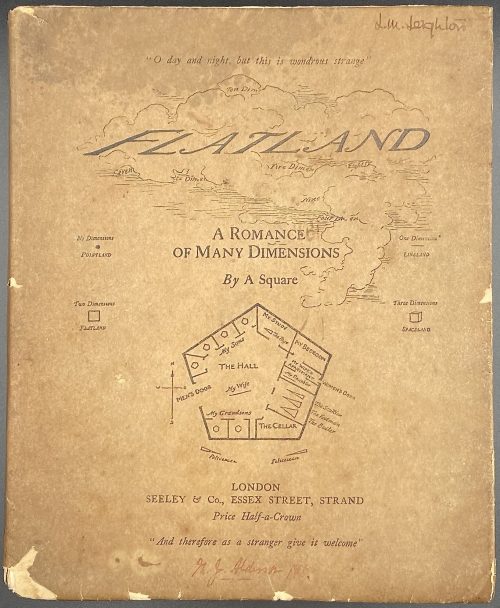 Title: FLATLAND | A Romance of Many Dimensions | With Illustrations | by the Author, A SQUARE | “fie, fie, how franticly I square may talk!” | NEW AND REVISED EDITION | LONDON | SEELEY & Co., 46, 47 & 48, ESSEX STREET, STRAND | (Late of 54 Fleet Street) | 1884 || Pagination: 2 blank leaves, [2] – h.t. / blank, [2] – t.p. / imprint., [2] – dedication / blank, [ix] x-xvi, [1, 2] f.t. / blank, [3] 4-102, 2 blank leaves; in-text woodcuts. Collation: [A]8 B-H8. Binding: original wrappers in pictorial parchment jacket, printed on laid paper, lower and lateral margins untrimmed. Note: This is the 2nd edition published the same year as the 1st, revised, as stated. I did not compare the two, neither I am planning to acquire the first 1st edition in a foreseeable future. This is a lifetime edition, handled by the Author himself, and that's enough for me to be quite happy.
Title: FLATLAND | A Romance of Many Dimensions | With Illustrations | by the Author, A SQUARE | “fie, fie, how franticly I square may talk!” | NEW AND REVISED EDITION | LONDON | SEELEY & Co., 46, 47 & 48, ESSEX STREET, STRAND | (Late of 54 Fleet Street) | 1884 || Pagination: 2 blank leaves, [2] – h.t. / blank, [2] – t.p. / imprint., [2] – dedication / blank, [ix] x-xvi, [1, 2] f.t. / blank, [3] 4-102, 2 blank leaves; in-text woodcuts. Collation: [A]8 B-H8. Binding: original wrappers in pictorial parchment jacket, printed on laid paper, lower and lateral margins untrimmed. Note: This is the 2nd edition published the same year as the 1st, revised, as stated. I did not compare the two, neither I am planning to acquire the first 1st edition in a foreseeable future. This is a lifetime edition, handled by the Author himself, and that's enough for me to be quite happy. -
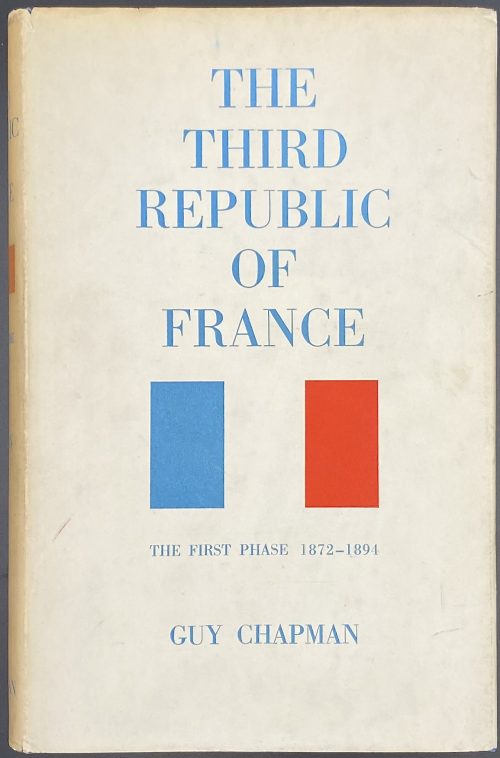 Title: THE | THIRD REPUBLIC | OF FRANCE | THE FIRST PHASE 1871–1894 | BY | GUY CHAPMAN | Sometime Professor of Modern History in the University of Leeds | LONDON | MACMILLAN & CO LTD | NEW YORK • ST. MARTIN’S PRESS | 1962 Pagination: [i-iv] v-xxii, [1] 2-433 [434 imprint]. Collation: 8vo; [A]8 B-Z8 2A-2D8 2E2 2E210. Binding: blue buckram, bronze lettering to spine, pictorial DJ. Publishing year 1963 according to worldcat. Author: Chapman, Guy Patterson (British, 1889 – 1972)
Title: THE | THIRD REPUBLIC | OF FRANCE | THE FIRST PHASE 1871–1894 | BY | GUY CHAPMAN | Sometime Professor of Modern History in the University of Leeds | LONDON | MACMILLAN & CO LTD | NEW YORK • ST. MARTIN’S PRESS | 1962 Pagination: [i-iv] v-xxii, [1] 2-433 [434 imprint]. Collation: 8vo; [A]8 B-Z8 2A-2D8 2E2 2E210. Binding: blue buckram, bronze lettering to spine, pictorial DJ. Publishing year 1963 according to worldcat. Author: Chapman, Guy Patterson (British, 1889 – 1972) -
![[Philip Graves]. The Truth About "The Protocols" : A Literary Forgery / From the Times of August 16, 17, and 18, 1921. — London: [The Times, 1921]. — pp.: [2 title, coloph.] 3-24.](https://varshavskycollection.com/wp-content/uploads/2021/02/LIB-2496.2020-a-500x796.jpeg) A contemporary reprint in publisher's wrappers, 22.8 x 14.4 cm, untrimmed, stapled, with title on the outer cover and similar to t.p.: The Truth About | "The Protocols" | A LITERARY FORGERY | From The Times of | August 16, 17, and 18, 1921 | LONDON: | PRINTING HOUSE SQUARE, E.C.4. | ONE SHILLING NET. || Pagination: [2] – t.p. / colophon, 3-24. Collation: [A]2 B10.
A contemporary reprint in publisher's wrappers, 22.8 x 14.4 cm, untrimmed, stapled, with title on the outer cover and similar to t.p.: The Truth About | "The Protocols" | A LITERARY FORGERY | From The Times of | August 16, 17, and 18, 1921 | LONDON: | PRINTING HOUSE SQUARE, E.C.4. | ONE SHILLING NET. || Pagination: [2] – t.p. / colophon, 3-24. Collation: [A]2 B10. -
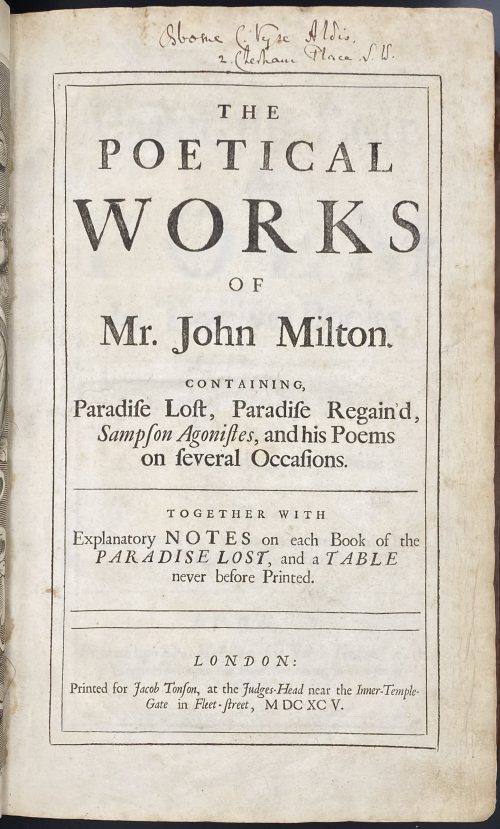 THE | POETICAL | WORKS | OF | Mr. John Milton. | Paradise Lost, Paradise Regained, | Sampson Agonistes, and his Poems | on several Occasions. | TOGETHER WITH | Explanatory NOTES on each Book of the | PARADISE LOST, and a TABLE | never before Printed. | LONDON: | Printed for Jacob Tonson, at Judges-Head near Inner-Temple-| Gate in Fleet – street , M DC XC V. || Pagination: [6] 1-343 [5] 1-66 [4] 1-57 [5] 1-60 [2] 321 [1], frontispiece and 12 plates, one before each book of Paradise Lost. Collation: 4to, folio; blank leaf, π3 B2, C-Z4, Aa-Yy4, A-H4 I2, [A]-D2 †D2 E-Q2 [A]1 B-Z2 Aa-Zz2 Aaa-Zzz2 Aaaa-Mmmm2 [N]1, 2 blank leaves, + frontis. portrait and 12 plates extraneous to collation. Plates: Portrait of John Milton (British, 1608 – 1674) engraved by Robert White (British, 1645 – 1703) after William Faithorne (British, 1616 – 1691) 11 plates engraved by Michael Burghers (Dutch, c. 1640 – c. 1723) after John Baptiste de Medina (Flemish, 1659 –1710); 1 plate (for Book IV) engraved by Peter-Paul Bouché (Dutch, 1646 – c. 1697) after Bernard Lens (British, 1659 – 1725). Binding: Folio, bound in full contemporary English panelled and speckled calf, tooled in blind, re-backed, corners repaired, the lines in Paradise Lost numbered; title pages of Paradise Regain'd and Samson Agonistes dated 1695; without a list of subscribers after the general title; with the Table for Paradise Lost; printed on laid paper, with tall "s", margins sprayed red. Provenance: near-contemporary ex libris of Sarah Bugg inside front board; along with that of Sam Bontham, 1726; later owned by forger Osborne Charles Vyse Aldis (1843 – 1916), with his signature on general title, with a nine-line note in his hand and initialled on page 343. Catalogue raisonné: Gordon N. Ray, Illustrated book in England (1976): p. 3. Ref: National Gallery of Art Contributors: Bouché, Peter-Paul (Dutch, 1646 – c. 1697) Burghers, Michael (Dutch, c. 1640 – c. 1723) Faithorne, William (British, 1616 – 1691) Lens, Bernard (British, 1659 – 1725) Medina, John Baptiste de (Flemish, 1659 – 1710) Milton, John (British, 1608 – 1674) Tonson, Jacob, the Elder (British, 1655 – 1736) White, Robert (British, 1645 – 1703)
THE | POETICAL | WORKS | OF | Mr. John Milton. | Paradise Lost, Paradise Regained, | Sampson Agonistes, and his Poems | on several Occasions. | TOGETHER WITH | Explanatory NOTES on each Book of the | PARADISE LOST, and a TABLE | never before Printed. | LONDON: | Printed for Jacob Tonson, at Judges-Head near Inner-Temple-| Gate in Fleet – street , M DC XC V. || Pagination: [6] 1-343 [5] 1-66 [4] 1-57 [5] 1-60 [2] 321 [1], frontispiece and 12 plates, one before each book of Paradise Lost. Collation: 4to, folio; blank leaf, π3 B2, C-Z4, Aa-Yy4, A-H4 I2, [A]-D2 †D2 E-Q2 [A]1 B-Z2 Aa-Zz2 Aaa-Zzz2 Aaaa-Mmmm2 [N]1, 2 blank leaves, + frontis. portrait and 12 plates extraneous to collation. Plates: Portrait of John Milton (British, 1608 – 1674) engraved by Robert White (British, 1645 – 1703) after William Faithorne (British, 1616 – 1691) 11 plates engraved by Michael Burghers (Dutch, c. 1640 – c. 1723) after John Baptiste de Medina (Flemish, 1659 –1710); 1 plate (for Book IV) engraved by Peter-Paul Bouché (Dutch, 1646 – c. 1697) after Bernard Lens (British, 1659 – 1725). Binding: Folio, bound in full contemporary English panelled and speckled calf, tooled in blind, re-backed, corners repaired, the lines in Paradise Lost numbered; title pages of Paradise Regain'd and Samson Agonistes dated 1695; without a list of subscribers after the general title; with the Table for Paradise Lost; printed on laid paper, with tall "s", margins sprayed red. Provenance: near-contemporary ex libris of Sarah Bugg inside front board; along with that of Sam Bontham, 1726; later owned by forger Osborne Charles Vyse Aldis (1843 – 1916), with his signature on general title, with a nine-line note in his hand and initialled on page 343. Catalogue raisonné: Gordon N. Ray, Illustrated book in England (1976): p. 3. Ref: National Gallery of Art Contributors: Bouché, Peter-Paul (Dutch, 1646 – c. 1697) Burghers, Michael (Dutch, c. 1640 – c. 1723) Faithorne, William (British, 1616 – 1691) Lens, Bernard (British, 1659 – 1725) Medina, John Baptiste de (Flemish, 1659 – 1710) Milton, John (British, 1608 – 1674) Tonson, Jacob, the Elder (British, 1655 – 1736) White, Robert (British, 1645 – 1703) -
 Volume 1: Land birds – 7th edition; Supplement: 1st edition. Title: A | HISTORY | OF | BRITISH BIRDS. | THE FIGURES ENGRAVED ON WOOD BY T. BEWICK. | VOL. I. | CONTAINING THE | HISTORY AND DESCRIPTION OF LAND BIRDS | — | AND | A SUPPLEMENT, WITH ADDITIONAL FIGURES. | — | NEWCASTLE: | PRINTED BY EDWARD WALKER, PILGRIM STREET, | FOR T. BEWICK : SOLD BY HIM, AND E. CHARNLEY, NEWCASTLE ; | AND LONGMAN AND CO. LONDON. | 1821. || Pagination: [2 blanks], [i, ii] – t.p. / blank, [iii] iv-xl, [43] 44-330, [2] – suppl. t.p. / blank, [1] 2-46 [47] – contents, [48] – advert., [2 blanks]. Collation: 8vo in fours; π1 A-C4 E3 F-2S4 π1 B-G4; I2, N2, and 2A2 unsigned. Woodcuts: 157 descriptions of birds, 140 figures of birds, 127 vignettes, tail-pieces, figures in text, etc. Volume 2: Water birds – 5th edition; Supplement: 1st edition. Title: A | HISTORY | OF | BRITISH BIRDS. | THE FIGURES ENGRAVED ON WOOD BY T. BEWICK. | VOL. II. | CONTAINING THE | HISTORY AND DESCRIPTION OF WATER BIRDS | — | AND | A SUPPLEMENT, WITH ADDITIONAL FIGURES. | — | NEWCASTLE: | PRINTED BY EDWARD WALKER, PILGRIM STREET, | FOR T. BEWICK : SOLD BY HIM, AND E. CHARNLEY, NEWCASTLE ; | AND LONGMAN AND CO. LONDON. | 1821. || Pagination: [2 blanks], [i, ii] – t.p. / blank, [iii] iv-xxii, [19] 20-360, [2] – suppl. t.p. / blank, [1] 2-43 [44] – contents, [1] 2-7 – addenda., [8] – imprint, [2 blanks]. Collation: 8vo in fours; π1 A-B4 *B2 C-2X4 2Y3 π1 B-F4 G2 [H]4; E2, F2, G2, 2G2, 2T2 and Suppl. G2 and Addenda unsigned. Woodcuts: 162 descriptions of birds, 125 figures of birds, 137 vignettes, tail-pieces, figures in text, etc. Both volumes: Size: 21.3 x 14 cm; page: 20.7 x 13.1 cm, demy. Binding: Green half-calf over marbled boards, blind-ruled raised bands with gilt ornament, crimson gilt-ruled and lettered labels to spine. For the first edition see: LIB-2614.2021 Catalogue raisonné: Hugo (1866): № (99) 94 –120 (108) / pp. 40-58; Roscoe (1953): № 24 a-c, 25 a-c, 26 a-c, 27 a-c, 28 / pp. 104 - 114.
Volume 1: Land birds – 7th edition; Supplement: 1st edition. Title: A | HISTORY | OF | BRITISH BIRDS. | THE FIGURES ENGRAVED ON WOOD BY T. BEWICK. | VOL. I. | CONTAINING THE | HISTORY AND DESCRIPTION OF LAND BIRDS | — | AND | A SUPPLEMENT, WITH ADDITIONAL FIGURES. | — | NEWCASTLE: | PRINTED BY EDWARD WALKER, PILGRIM STREET, | FOR T. BEWICK : SOLD BY HIM, AND E. CHARNLEY, NEWCASTLE ; | AND LONGMAN AND CO. LONDON. | 1821. || Pagination: [2 blanks], [i, ii] – t.p. / blank, [iii] iv-xl, [43] 44-330, [2] – suppl. t.p. / blank, [1] 2-46 [47] – contents, [48] – advert., [2 blanks]. Collation: 8vo in fours; π1 A-C4 E3 F-2S4 π1 B-G4; I2, N2, and 2A2 unsigned. Woodcuts: 157 descriptions of birds, 140 figures of birds, 127 vignettes, tail-pieces, figures in text, etc. Volume 2: Water birds – 5th edition; Supplement: 1st edition. Title: A | HISTORY | OF | BRITISH BIRDS. | THE FIGURES ENGRAVED ON WOOD BY T. BEWICK. | VOL. II. | CONTAINING THE | HISTORY AND DESCRIPTION OF WATER BIRDS | — | AND | A SUPPLEMENT, WITH ADDITIONAL FIGURES. | — | NEWCASTLE: | PRINTED BY EDWARD WALKER, PILGRIM STREET, | FOR T. BEWICK : SOLD BY HIM, AND E. CHARNLEY, NEWCASTLE ; | AND LONGMAN AND CO. LONDON. | 1821. || Pagination: [2 blanks], [i, ii] – t.p. / blank, [iii] iv-xxii, [19] 20-360, [2] – suppl. t.p. / blank, [1] 2-43 [44] – contents, [1] 2-7 – addenda., [8] – imprint, [2 blanks]. Collation: 8vo in fours; π1 A-B4 *B2 C-2X4 2Y3 π1 B-F4 G2 [H]4; E2, F2, G2, 2G2, 2T2 and Suppl. G2 and Addenda unsigned. Woodcuts: 162 descriptions of birds, 125 figures of birds, 137 vignettes, tail-pieces, figures in text, etc. Both volumes: Size: 21.3 x 14 cm; page: 20.7 x 13.1 cm, demy. Binding: Green half-calf over marbled boards, blind-ruled raised bands with gilt ornament, crimson gilt-ruled and lettered labels to spine. For the first edition see: LIB-2614.2021 Catalogue raisonné: Hugo (1866): № (99) 94 –120 (108) / pp. 40-58; Roscoe (1953): № 24 a-c, 25 a-c, 26 a-c, 27 a-c, 28 / pp. 104 - 114. -
 Artist: Utagawa Kunisada [歌川 国貞], a.k.a. Utagawa Toyokuni III [三代 歌川 豊国] (Japanese, 1786 – 1865). Signed: Toyokuni ga [豊国 画] in a red toshidama cartouche Block carver: Yokokawa Takejirō [横川竹二郎] (Japanese, fl. 1845 – 1863); seal: Hori Take [彫竹]. Publisher: Iseya Magobei [伊勢屋孫兵衛] (Japanese, fl. c. 1794 – 1868); seal: Hanmoto, Masu [板元, 益] (Marks 19-039 | 150d). Date-aratame seal: Ansei 2 (1855). Title: Time in Fukagawa, Iyo Province (Fukagawa Iyo setsu). Ref.: [LIB-3008.2022] Andreas Marks. Japanese woodblock prints: Artists, publishers and masterworks, 1680 – 1900. — Tuttle Publishing, 2010; p. 221. –> 1855 Kunisada. "Iyo Province-time at Fukagawa" (Fukagawa Iyo setsu). Fan print. Japan Ukiyo-e Museum, Matsumoto.
Artist: Utagawa Kunisada [歌川 国貞], a.k.a. Utagawa Toyokuni III [三代 歌川 豊国] (Japanese, 1786 – 1865). Signed: Toyokuni ga [豊国 画] in a red toshidama cartouche Block carver: Yokokawa Takejirō [横川竹二郎] (Japanese, fl. 1845 – 1863); seal: Hori Take [彫竹]. Publisher: Iseya Magobei [伊勢屋孫兵衛] (Japanese, fl. c. 1794 – 1868); seal: Hanmoto, Masu [板元, 益] (Marks 19-039 | 150d). Date-aratame seal: Ansei 2 (1855). Title: Time in Fukagawa, Iyo Province (Fukagawa Iyo setsu). Ref.: [LIB-3008.2022] Andreas Marks. Japanese woodblock prints: Artists, publishers and masterworks, 1680 – 1900. — Tuttle Publishing, 2010; p. 221. –> 1855 Kunisada. "Iyo Province-time at Fukagawa" (Fukagawa Iyo setsu). Fan print. Japan Ukiyo-e Museum, Matsumoto. -
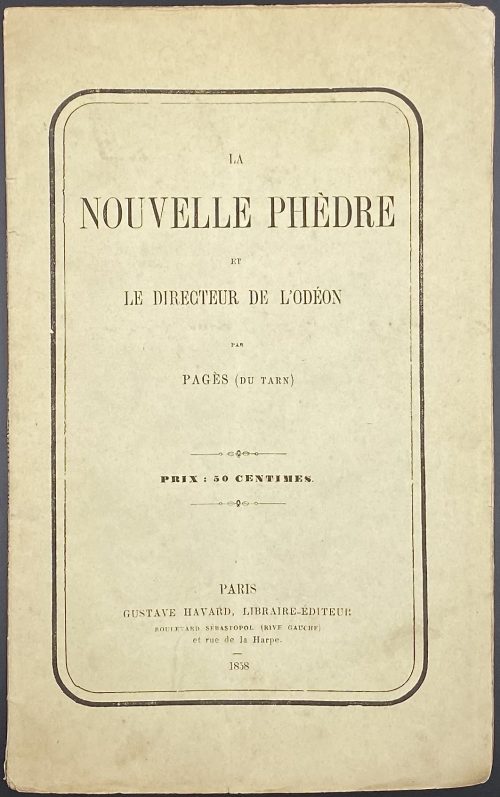 Cover: LA | NOUVELLE PHÈDRE | ET | LE DIRECTEUR DE L'ODEON | PAR | PAGES (DU TARN) | PRIX : 50 CENTIMES | PARIS | GUSTAVE HAVARD, LIBRAIRE–ÉDITEUR | BOULEVARD SÉBASTOPOL (RIVE GAUCHE) et rue de la Harpe. | 1858 || Pagination: [1-3] 4-48. Collation: 8vp; [1]-38 (total 24 leaves) Binding: publisher’s wrappers. Printer: Imprimerie Bonaventure et Ducessois (Paris); Ducessois, Théodore (French, 1804 – after 1864.) Bonaventure, Jules-Frédéric (French, ca. 1816 – 1891) Pagès (du Tarn) (French, fl. 1838 – 1872) – known absolutely nothing. Other works: La France, ode (M. Papailhiau, 1840); Aux Électeurs ... du Tarn (Soupe, 1848) ; Les Funérailles de Napoléon, ode (Pilout, 1840) ; Mazagran, 4, 5 et 6 février 1840, chant héroïque (M. Papailhiau, 1840) ; Herminie, ou l'Amour et l'honneur, tragédie en 5 actes, en vers (Moquet, 1872) ; Lettre à S.E. le ministre de l'Intérieur sur la nouvelle Phèdre et le Théâtre français (Moquet, 1856), etc. There is also a humorous book by Antony de Menou, which does not contain anything of substance: Un contemporain: biographie de Pagès (du Tarn). — Paris: Masgana, 1857. Antony de Menou is an obscure figure in his own right. An article about him can be found at Les derniers bohêmes by Firmin Maillard (1833 – 1901) [LIB-2652.2021].
Cover: LA | NOUVELLE PHÈDRE | ET | LE DIRECTEUR DE L'ODEON | PAR | PAGES (DU TARN) | PRIX : 50 CENTIMES | PARIS | GUSTAVE HAVARD, LIBRAIRE–ÉDITEUR | BOULEVARD SÉBASTOPOL (RIVE GAUCHE) et rue de la Harpe. | 1858 || Pagination: [1-3] 4-48. Collation: 8vp; [1]-38 (total 24 leaves) Binding: publisher’s wrappers. Printer: Imprimerie Bonaventure et Ducessois (Paris); Ducessois, Théodore (French, 1804 – after 1864.) Bonaventure, Jules-Frédéric (French, ca. 1816 – 1891) Pagès (du Tarn) (French, fl. 1838 – 1872) – known absolutely nothing. Other works: La France, ode (M. Papailhiau, 1840); Aux Électeurs ... du Tarn (Soupe, 1848) ; Les Funérailles de Napoléon, ode (Pilout, 1840) ; Mazagran, 4, 5 et 6 février 1840, chant héroïque (M. Papailhiau, 1840) ; Herminie, ou l'Amour et l'honneur, tragédie en 5 actes, en vers (Moquet, 1872) ; Lettre à S.E. le ministre de l'Intérieur sur la nouvelle Phèdre et le Théâtre français (Moquet, 1856), etc. There is also a humorous book by Antony de Menou, which does not contain anything of substance: Un contemporain: biographie de Pagès (du Tarn). — Paris: Masgana, 1857. Antony de Menou is an obscure figure in his own right. An article about him can be found at Les derniers bohêmes by Firmin Maillard (1833 – 1901) [LIB-2652.2021]. -
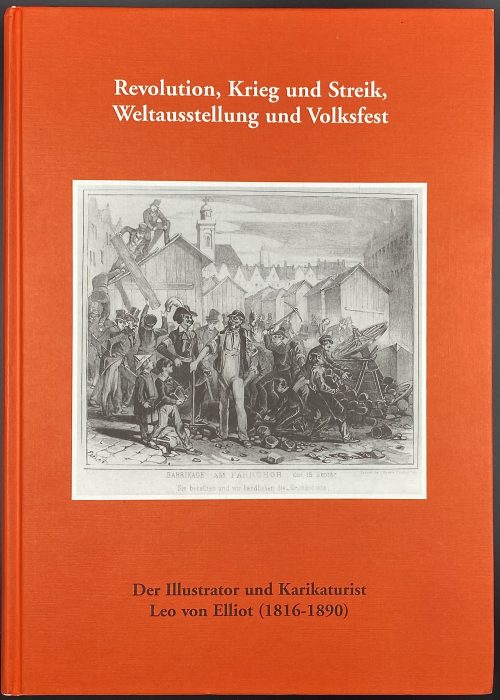 Title: Revolution, Krieg und Streik, | Weltausstellung und Volksfest | Der Illustrator und Karikaturist | Leo von Elliot (1816–1890) | von Eckhart G. Franz | Hessische Historische Kommission Darmstadt 2000 || Series: Arbeiten der Hessischen Historischen Kommission, Neue Folge Band 17. Pagination: [1-6] 7-340, 458 b/w illustration. Binding: hardcover, red pictorial boards, 30 x 21.5 cm.
Title: Revolution, Krieg und Streik, | Weltausstellung und Volksfest | Der Illustrator und Karikaturist | Leo von Elliot (1816–1890) | von Eckhart G. Franz | Hessische Historische Kommission Darmstadt 2000 || Series: Arbeiten der Hessischen Historischen Kommission, Neue Folge Band 17. Pagination: [1-6] 7-340, 458 b/w illustration. Binding: hardcover, red pictorial boards, 30 x 21.5 cm. -
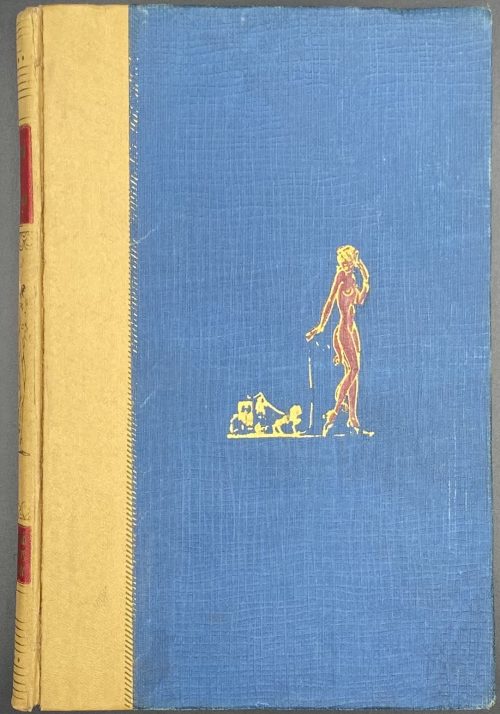 Title (chain border): CANDIDE | VOLTAIRE | ILLUSTRATIONS BY | MAHLON BLAINE | {vignette} | NEW YORK | Illustrated Editions Company | 220 FOURTH AVENUE || Title verso: (top) COPYRIGHT, 1930, BY WILLIAMS, BELASCO & MEYERS || (bottom) PRINTED IN THE UNITED STATES OF AMERICA | BY J. J. LITTLE & IVES COMPANY, NEW YORK || Pagination:[1-10] 11-144, headpiece, frontispiece and 5 plates after Blaine’s pen drawings, within the pagination; tailpieces by A. Zaidenberg. Binding: 21 x 14 cm; quarter beige buckram over blue cloth, stamped-gilt and red lettering and vignette to front board and spine. Binding in a way similar to Sterne's A sentimental journey published by Three Sirens Press in c. 1930 [LIB-2784.2021]. Not only that: tailpieces in this Illustrated Editions Company edition are the same as in Cameo Classic edition, with the only difference – here the name of the artist is stated, whether in the Cameo Classic it is not; see [LIB-2777.2021]. Bear in mind that Cameo Classic does not belong to Williams, Belasco and Meyers, it is a Grosset and Dunlap series. Compare Williams, Belasco and Meyers Candide and Illustrated Editions Company Candide title pages:
Title (chain border): CANDIDE | VOLTAIRE | ILLUSTRATIONS BY | MAHLON BLAINE | {vignette} | NEW YORK | Illustrated Editions Company | 220 FOURTH AVENUE || Title verso: (top) COPYRIGHT, 1930, BY WILLIAMS, BELASCO & MEYERS || (bottom) PRINTED IN THE UNITED STATES OF AMERICA | BY J. J. LITTLE & IVES COMPANY, NEW YORK || Pagination:[1-10] 11-144, headpiece, frontispiece and 5 plates after Blaine’s pen drawings, within the pagination; tailpieces by A. Zaidenberg. Binding: 21 x 14 cm; quarter beige buckram over blue cloth, stamped-gilt and red lettering and vignette to front board and spine. Binding in a way similar to Sterne's A sentimental journey published by Three Sirens Press in c. 1930 [LIB-2784.2021]. Not only that: tailpieces in this Illustrated Editions Company edition are the same as in Cameo Classic edition, with the only difference – here the name of the artist is stated, whether in the Cameo Classic it is not; see [LIB-2777.2021]. Bear in mind that Cameo Classic does not belong to Williams, Belasco and Meyers, it is a Grosset and Dunlap series. Compare Williams, Belasco and Meyers Candide and Illustrated Editions Company Candide title pages: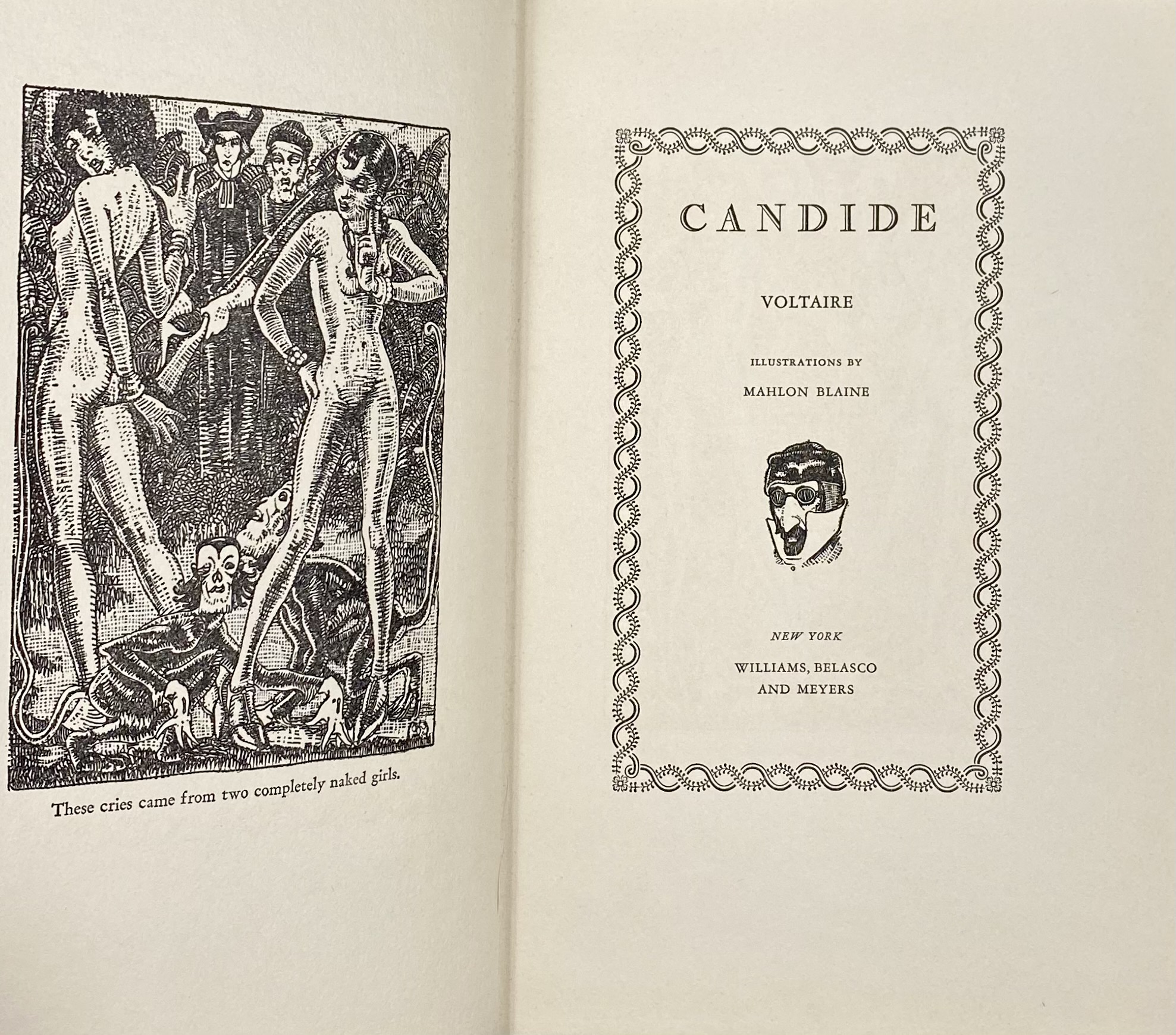
Williams, Belasco and Meyers
Arouet, François-Marie [Voltaire] (French, 1694 – 1778)– author. Woolf, Herman Irwell [Chambers, Dorset] (British, 1890 – 1958) – translator. Blaine, Mahlon [Hudson, G. Christopher] (American, 1894 – 1969) – illustrator. Zaidenberg, Arthur (American, 1902 – 1990) – illustrator. Williams, Belasco and Meyers (NY) – copyright holder. Illustrated Editions Company (1929-1942) – publisher. J. J. Little & Ives Company (NY) – printer. See the Cameo Classic reprint [LIB-2777.2021].
Illustrated Editions Company
-
 Two-volume large paper edition with 20 plates in two states. Vol. 1 (with plates). Title : CONTES | ET | NOUVELLES EN VERS. | PAR | JEAN DE LA FONTAINE. | — | TOME PREMIER| {vignette “P.P. Choffard 95”} | A PARIS, | DE L’IMPRIMERIE DE P. DIDOT L'AÎNÉ. | L’AN III DE LA RÉPUBLIQUE. | M. DCC. XCV. || Pagination: [2] [i-iv] v-vii [viii], 1-280 [2 table] [2], total 294 pages, ils. Collation: 4to; 1 blank, π4 (π3a signed “a”), 1-354 361, 1 blank, total 147 leaves, plus 40 leaves of plates with tissue guards, after Fragonard and others, which represent 20 engravings, each in two states, before and after letters, besides №9 (Le Calendrier des Vieillards by Jean Dambrun after Fragonard), which has two identical copies, both before letters. Vol. 2. (without plates) Title: same, but TOME SECOND. Pagination: [2] [4] 1-334 [2], total 342 pages. Collation: 4to; 1 blank, π2 1-414 423 1 blank, total 167 leaves. Binding: Two volumes uniformly bound in crimson straight-grain morocco, ruled in gilt, gilt-decorated flat spine with lettering, board edges and turn-ins tooled with gilt dentelles, marbled endpapers, three bookplates to front pastedown, top edge trimmed, 2nd volume partly uncut; text and plates printed on thick Dutch wove paper. Size: volumes: 33.3 x 25.2 cm; leaves: 31.5 x 23.5 cm. Provenance: Bishop, Cortlandt Field (American, 1870 – 1935) – bookplate. Mary S. Collins – bookplate by J. H. Fincken. Robin F. Satinsky (American, 1919 – 2008) – Robin Collection bookplate. Catalogue raisonné: Ray (French): 133-137; Cohen-DeRicci 573-582 ; Lewine : 281-282. CONTRIBUTORS: Jean de La Fontaine (French, 1621–1695) – author. Pierre Didot (French, 1761–1853) – publisher, printer. Artists: Jean-Honoré Fragonard (French, 1732–1806) Jean Baptiste Mallet (French, 1759–1835) Jacques Louis François Touzé (French, 1747–1807) Charles Monnet (French, 1732–after 1808) Engravers: Jacques Aliamet (French, 1726–1788) Jean Dambrun (French, 1741–about 1808) Jean Louis Delignon (French, 1755–about 1804) Jean Baptiste Michel Dupréel (French, active 1787–1817) Louis Michel Halbou (French, 1730–1809) Charles Louis Lingée (French, 1748–1819) Charles Emmanuel Jean Baptiste Patas (French, 1744–1802) Jean Baptiste Simonet (French, 1742–1813) Jean Baptiste Tilliard (French, 1740–1823) Philippe Trière (French, 1756–about 1815) Pierre-Philippe Choffard (French, 1730–1809) – t.p. vignette PLATES (collation order): №8: Fragonard / Trière – La Gageure des trois Commères №1*: Fragonard / Lingée – Joconde №1**: Mallet / Trière – Joconde №2: Fragonard / Delignon – Le Cocu battu et content №3: Fragonard / Tilliard – Le Mari confesseur №4: Fragonard / Dambrun – Le Savetier №5: Fragonard / Lingée – Le Paysan qui avait offensé son Seigneur №9: Fragonard / Dambrun – Le Calendrier des Vieillards №10: Fragonard / Aliamet – A Femme avare galant Escroc №12: Fragonard / Halbou – Le Gascon puni №11: Fragonard / Patas – On ne s’avise jamais de tout №13: Monnet / Tilliard – La Fiancée du roi de Garbe №14: Fragonard / Dupréel – La Coupe enchantée №15: Fragonard / Tilliard – Le Faucon №17: Fragonard / Patas – Le Pâté d’Anguilles №18: Fragonard / Tilliard – Le Magnifique №19: Fragonard / Delignon – La Matrone d’Ephèse №20: Fragonard / Patas – Belphégor №22: Touzé / Simonet – Le Glouton №26: Touzé / Lingée – Le Baiser rendu
Two-volume large paper edition with 20 plates in two states. Vol. 1 (with plates). Title : CONTES | ET | NOUVELLES EN VERS. | PAR | JEAN DE LA FONTAINE. | — | TOME PREMIER| {vignette “P.P. Choffard 95”} | A PARIS, | DE L’IMPRIMERIE DE P. DIDOT L'AÎNÉ. | L’AN III DE LA RÉPUBLIQUE. | M. DCC. XCV. || Pagination: [2] [i-iv] v-vii [viii], 1-280 [2 table] [2], total 294 pages, ils. Collation: 4to; 1 blank, π4 (π3a signed “a”), 1-354 361, 1 blank, total 147 leaves, plus 40 leaves of plates with tissue guards, after Fragonard and others, which represent 20 engravings, each in two states, before and after letters, besides №9 (Le Calendrier des Vieillards by Jean Dambrun after Fragonard), which has two identical copies, both before letters. Vol. 2. (without plates) Title: same, but TOME SECOND. Pagination: [2] [4] 1-334 [2], total 342 pages. Collation: 4to; 1 blank, π2 1-414 423 1 blank, total 167 leaves. Binding: Two volumes uniformly bound in crimson straight-grain morocco, ruled in gilt, gilt-decorated flat spine with lettering, board edges and turn-ins tooled with gilt dentelles, marbled endpapers, three bookplates to front pastedown, top edge trimmed, 2nd volume partly uncut; text and plates printed on thick Dutch wove paper. Size: volumes: 33.3 x 25.2 cm; leaves: 31.5 x 23.5 cm. Provenance: Bishop, Cortlandt Field (American, 1870 – 1935) – bookplate. Mary S. Collins – bookplate by J. H. Fincken. Robin F. Satinsky (American, 1919 – 2008) – Robin Collection bookplate. Catalogue raisonné: Ray (French): 133-137; Cohen-DeRicci 573-582 ; Lewine : 281-282. CONTRIBUTORS: Jean de La Fontaine (French, 1621–1695) – author. Pierre Didot (French, 1761–1853) – publisher, printer. Artists: Jean-Honoré Fragonard (French, 1732–1806) Jean Baptiste Mallet (French, 1759–1835) Jacques Louis François Touzé (French, 1747–1807) Charles Monnet (French, 1732–after 1808) Engravers: Jacques Aliamet (French, 1726–1788) Jean Dambrun (French, 1741–about 1808) Jean Louis Delignon (French, 1755–about 1804) Jean Baptiste Michel Dupréel (French, active 1787–1817) Louis Michel Halbou (French, 1730–1809) Charles Louis Lingée (French, 1748–1819) Charles Emmanuel Jean Baptiste Patas (French, 1744–1802) Jean Baptiste Simonet (French, 1742–1813) Jean Baptiste Tilliard (French, 1740–1823) Philippe Trière (French, 1756–about 1815) Pierre-Philippe Choffard (French, 1730–1809) – t.p. vignette PLATES (collation order): №8: Fragonard / Trière – La Gageure des trois Commères №1*: Fragonard / Lingée – Joconde №1**: Mallet / Trière – Joconde №2: Fragonard / Delignon – Le Cocu battu et content №3: Fragonard / Tilliard – Le Mari confesseur №4: Fragonard / Dambrun – Le Savetier №5: Fragonard / Lingée – Le Paysan qui avait offensé son Seigneur №9: Fragonard / Dambrun – Le Calendrier des Vieillards №10: Fragonard / Aliamet – A Femme avare galant Escroc №12: Fragonard / Halbou – Le Gascon puni №11: Fragonard / Patas – On ne s’avise jamais de tout №13: Monnet / Tilliard – La Fiancée du roi de Garbe №14: Fragonard / Dupréel – La Coupe enchantée №15: Fragonard / Tilliard – Le Faucon №17: Fragonard / Patas – Le Pâté d’Anguilles №18: Fragonard / Tilliard – Le Magnifique №19: Fragonard / Delignon – La Matrone d’Ephèse №20: Fragonard / Patas – Belphégor №22: Touzé / Simonet – Le Glouton №26: Touzé / Lingée – Le Baiser rendu -
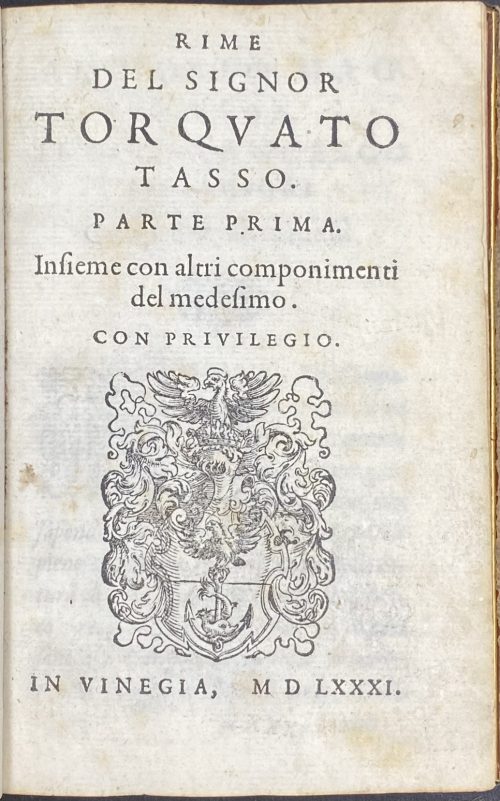 Title-page: RIME | DEL SIGNOR | TORQUATO | TASSO. | PARTE PRIMA. | Insieme con altri componimenti | del medesimo | CON PRIVILEGIO. | {publisher’s device} | IN VINEGIA, M D LXXXI. || Contents: 1. Rime; 2. Aminta favola boscareccia; 3. Conclusioni amorose; 4. Il Romeo, overo del Giuoco dialogo; 5. Lettera, nellaquale paragona l’Italia alla Francia; 6. All’eccellentis signor Duca di Urbino; 7. Dialogo del l’amor. Pagination: [2 blanks], [2] – t.p. / blank, [4] dedication, [2] – blank / content, [16] – tavola, [1] 2-160 – rime, [8] [1] 2-74 – aminta, [4] 1-9 [10 blank] – conclusion, [2] [1]-22 – dialogo, [2] 1-27 [28 blank] – lettera, [2] 1-4 – all’eccellentiss, [4 blanks], [2] 1-17 [18 blank] – dialogo del l’amor, [2] – Car. 52 / Car. 113., [4 blanks], total 372 pages. Collation: 8vo; first blank, *4, **8, A-K8, 2A-2L8 M4, last blank; total 186 leaves, incl. first and last blanks. Note: 2F2, 2G1, 2K4, 2L1, and 2M3,4 – unsigned. Binding: 15.2 x 10.3 cm, 19th-century polished calf by Duke St., St. James, London (ticket) Cambridge panels ruled in gilt with fleurons at corners, two crimson labels to spine with gilt lettering, gilt in compartments, raised bands ruled gilt, rebacked, AEG, bookplate to front pastedown: “BIBLIOTECA | del | Conte Leonardo Vitetti | Ambasciatore d’Italia” in a frame, and “The Robin Collection” to FEP. Inset a card from Bryn Mawr College Library. Provenance: Satinsky, Robin F. (American, 1919 – 2008), The Robin Collection. Count Leonardo Vitetti (Italian, 1895 – 1973) Bryn Mawr College Library (Pennsylvania) Contributors: Torquato Tasso (Italian, 1544 –1595) – author. Aldus Manutius, the Younger (Italian, 1547 – 1597) – printer, publisher.
Title-page: RIME | DEL SIGNOR | TORQUATO | TASSO. | PARTE PRIMA. | Insieme con altri componimenti | del medesimo | CON PRIVILEGIO. | {publisher’s device} | IN VINEGIA, M D LXXXI. || Contents: 1. Rime; 2. Aminta favola boscareccia; 3. Conclusioni amorose; 4. Il Romeo, overo del Giuoco dialogo; 5. Lettera, nellaquale paragona l’Italia alla Francia; 6. All’eccellentis signor Duca di Urbino; 7. Dialogo del l’amor. Pagination: [2 blanks], [2] – t.p. / blank, [4] dedication, [2] – blank / content, [16] – tavola, [1] 2-160 – rime, [8] [1] 2-74 – aminta, [4] 1-9 [10 blank] – conclusion, [2] [1]-22 – dialogo, [2] 1-27 [28 blank] – lettera, [2] 1-4 – all’eccellentiss, [4 blanks], [2] 1-17 [18 blank] – dialogo del l’amor, [2] – Car. 52 / Car. 113., [4 blanks], total 372 pages. Collation: 8vo; first blank, *4, **8, A-K8, 2A-2L8 M4, last blank; total 186 leaves, incl. first and last blanks. Note: 2F2, 2G1, 2K4, 2L1, and 2M3,4 – unsigned. Binding: 15.2 x 10.3 cm, 19th-century polished calf by Duke St., St. James, London (ticket) Cambridge panels ruled in gilt with fleurons at corners, two crimson labels to spine with gilt lettering, gilt in compartments, raised bands ruled gilt, rebacked, AEG, bookplate to front pastedown: “BIBLIOTECA | del | Conte Leonardo Vitetti | Ambasciatore d’Italia” in a frame, and “The Robin Collection” to FEP. Inset a card from Bryn Mawr College Library. Provenance: Satinsky, Robin F. (American, 1919 – 2008), The Robin Collection. Count Leonardo Vitetti (Italian, 1895 – 1973) Bryn Mawr College Library (Pennsylvania) Contributors: Torquato Tasso (Italian, 1544 –1595) – author. Aldus Manutius, the Younger (Italian, 1547 – 1597) – printer, publisher.